BUTTERFLY CONSERVATION IRELAND ANNUAL REPORT 2017
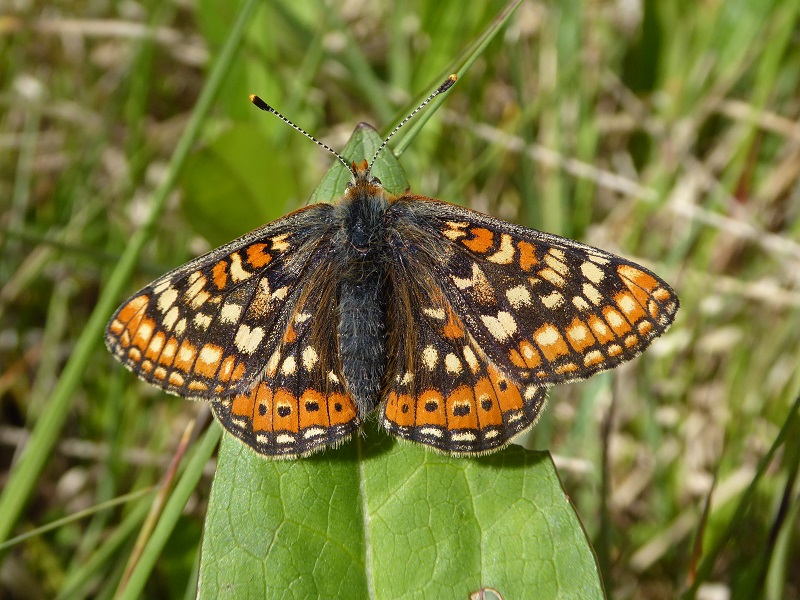
CONTENTS
- Introduction
- Butterfly Season Report
- Events Report
- Crabtree Nature Reserve Report
- Conservation News
- Garden Survey Report
- Red Admiral Garden Survey
- Garden Moth Scheme
- Species Focus: Hedge Brown
- Hungary for Butterflies
Introduction
Dear Butterfly Conservation Ireland Member,
Welcome to Butterfly Conservation Ireland’s Annual Report 2017. The year 2017 saw varied weather conditions but with less sunshine in July, August and September than we hoped for. Fortunately, there was some beautiful spring weather which provided a wonderful opportunity to enjoy our countryside and butterflies. The assault on our public green spaces by state-funded bodies and the proposed changes to the closed season for hedge-cutting and upland burning in the Heritage Bill made for a very demanding year defending our natural heritage from unnecessary interference and destruction. Our small staff are fortunate in having excellent support from our active membership whenever help is needed in these endeavours. Your continued practical and financial support is greatly appreciated as we strive to ensure that our butterflies and moths continue to have an important voice for their conservation. Be assured that the conservation agenda is pursued at every opportunity. Our financial accounts were passed so thanks are due to our joint treasurers Michael Jacob and Joseph Harding. Thanks are due to Richella Duggan and Pat Bell for help in editing this report and to all who contributed to its contents and to all of our members and supporters. We hope that you enjoy reading our Annual Report 2017 and we look forward to hearing from you in 2018.
Yours in nature,
Jesmond Harding [Secretary]
Butterfly Conservation Ireland,
Pagestown,
Maynooth,
County Kildare.
Butterfly Season Report 2017
The weather for 2017 was kinder to butterflies than 2016 but 2017 was not a landmark year. The greatest known butterfly years in this part of the world were 1893, 1976, 1989 and 1990. These years saw long, hot summers. The years had different butterfly results because of the weather contexts in which they occurred. For example, the legendary summer of 1976 was not as good a summer as 1989 which had more hot, sunny days and fewer poor days but 1976 had far greater butterfly populations than 1989. This was because 1976 followed two good summers so that populations had been building. On the other hand, 1989 followed three appalling summers which had seriously depressed butterfly numbers. However, wonderful prolonged sunshine does not always benefit butterfly populations. June, July and August 1976 had little rain. The following year some species populations crashed because drought caused many larvae to starve on dehydrated and shrivelled food plants. Another notable summer was in 1995 which followed a miserable spring. The summers of 2005 and 2006 were very good for butterflies. The summer of 2017 did not deliver spectacular numbers.
In Ireland the butterfly flight season runs from March to October with some outliers. The weather in March was generally unsettled, changeable and largely mild, though wet overall especially in the West. An anticyclone then built over Ireland bringing a fine and settled spell at the beginning of the final week. This gave ample sunshine countrywide and some of the highest temperatures of the month. However, it was short lived as low pressure and unsettled conditions returned for the final days when it was a lot cloudier and more humid with occasional rain. Two warm spells early and late in March brought out our species that over-winter as adults with Brimstone numbers especially impressive.

However, spring’s outstanding butterfly in much of east and the south of Ireland, and probably in many other areas was the Holly Blue. It seemed to be everywhere, with records from places it had been rare in or absent from in recent years. It showed up earlier in some areas with early April records from Donegal. A record of 26 Holly Blues from Athy on April 8th, a beautiful day, announced its prominence for the rest of spring. However, this abundance was not repeated in its second brood in July and August. April’s weather really helped spring butterflies. It was mild and dry nearly everywhere, and exceptionally dry, due mainly to the overall prevalence of high pressure. While the early part of the first week was changeable an anticyclone built over Ireland from the South on the 4th which lasted for much of the month, only becoming unsettled in the last week.
May was warm everywhere; drier than normal in most places. Good weather continued for much of the month with a rainy hiccup in week three, at the weekends after the month’s second weekend and near the end of May. These generally good conditions created good showings of Dingy Skipper, Cryptic Wood White, Wood White, Brimstone, Orange-tip, Green-veined White, Marsh Fritillary, Pearl-bordered Fritillary and even some good numbers of Wall Browns but only in areas where they are still well represented. Small Blue appeared in the third week in May in north Dublin but it did not appear in significant numbers until well into June along the Dublin coast. Common Blues also appeared in May, beginning on 8th May but this butterfly was not reported in high numbers anywhere; no count came near 100, a figure often reached on good sites. Large and Small White, always less numerous in the first brood presented themselves with Large White numbers hinting towards a big second brood. The Painted Lady had a strong showing in May and although it did not reach the population heights of 2016, it was still widespread. Interestingly, Red Admiral (the first and last butterfly reported to BCI in 2017) also promised to have a good year, and duly delivered.
June was changeable, unsettled and dull, but it was warm. The third week was especially warm though it was cloudier in the far northwest. It became unsettled again for the final week as low pressure returned, bringing lengthy spells of rain and it was notably dull on the final days. Small Heath showed in modest numbers with peak counts of 25 in Ballymacshoneen, Cork on 3rd June and in Sheskinmore, Donegal on 20th June. The last Small Heath record received was on 2nd September. The Large Heath was reported from Donegal and Kildare bogs only (a high of 20 was seen on 19th June). Only by dedicated searches of wet bogs in various parts of the country during June can the species status be revealed. Similarly, the Green Hairstreak was reported from Donegal and Kildare only, which does not allow any broad interpretation of its standing.
July was changeable with rain or showers most days. There were transient ridges of high pressure which brought a number of fine, warm days, but there were no settled spells. Locally heavy falls of rain occurred during thunderstorms, especially in the second half of the month. The first half of the month saw some fine weather and up to this point the season suggested that it could yield some spectacular results; early second brood Wall on 16th July (often not seen until mid-August) the earliest Brown Hairstreak record was from 17th July (usually end of July-early August) along with very early second brood Wood Whites. Some high counts of Dark Green Fritillary were received, with over 100 from Sheskinmore, Donegal. Silver-washed Fritillary appeared to be as widespread as in previous years but no report of large numbers was obtained from any area. It did have a long flight season, from 2nd July to 1st September. The poor weather in July and August may have extended the season. July saw an abundance of Ringlets but no notably high Meadow Brown counts. July 5th was the first date the Grayling (Howth, Dublin) was reported while 1st September (Bunbeg, Donegal) was the latest date but too few records were received to make any assessment of this species health. Only one report of Small Skipper was received. Its habitat was damaged by machinery and numbers were expected to be low. Two reports of Essex Skipper, one from Kildare, the other for Wexford, yielded a combined total of 26 individuals. However, other reports we heard suggest that the butterfly is thriving in the south-east. Low numbers of Hedge Brown were recorded in 2017.
August was a major disappointment. It was cool and dull, unsettled and very changeable with some very heavy rain later in the month. The butterfly season’s momentum was lost. These conditions meant that the big finale did not occur for the Small Tortoiseshell. The Small Copper was present in small numbers, with only five representing the highest number of individuals seen in one place. Peacocks showed in fairly high numbers, with 122 seen at Lullybeg, Kildare on 7th August when 21 Brimstones were also observed in this location. One impressive count was 18 Brown Hairstreaks in the Burren at Gortlecka, Clare, on 9th August by J.M. Harding and J.K. Lovatt who recorded 19 adult butterfly species (20 if Marsh Fritillary larvae are included) on that date in the Burren, in Clare and Galway. It was a memorable day in an otherwise forgettable month.
The first half of September continued in this vein. However, although high pressure built gradually and prevailed for the third week bringing a lot of bright and dry weather it was cool with chilly nights. The latter part of the month was changeable once again with fronts bringing some heavy spells of rain – especially on the 27th, though there were some dry days too with warm sunshine. Thirteen species were reported during September with the Red Admiral showing in high figures. Counts of 15-30 were frequent. This trend continued throughout a mild October and into early November, when all but one of the records received were of the Red Admiral. It is fitting that this species made the final imprint on the records for 2017 as it had an outstanding year.
This report is based on the records sent to Butterfly Conservation Ireland by a number of experienced observers. These records are published on the Butterfly Conservation Ireland website. We thank the recorders who sent in their reports which makes this report possible.
To record our butterflies in 2018, send your records by email to conservation.butterfly@gmail.com telling us:
your name/s, date of find, species found, the life stage/s found, numbers seen,
location the butterfly/moth was found (e.g. townland name, site name, county),
six figure grid reference, including the letter identifying the 1000-meter grid square in which the location lies (see http://www.gridreference.ie/ or Discovery Series maps)
weather conditions
and any other interesting comments you wish to provide.
Example: John Smith 14/06/12. 14 Small Blues, 15 Small Heaths, Portrane sand dunes, O254515, County Dublin. Small Blues feeding on Kidney Vetch and Creeping Thistle. Sunny, light breeze, around 18 degrees Celsius.
Records Policy
Butterfly Conservation Ireland may publish the details you send on its website unless you ask us not to reveal the record. Sensitive records may be published without grid references included. The records will be stored and will be used to monitor range and distribution trends and to raise conservation concerns.
Events Report 2017
Love of butterflies and moths and the desire to observe, collect, paint, record, study and enjoy butterflies may have always been present in Ireland, Britain and in the wider world but the first recorded lepidopterist in this part of the world was England’s Thomas Moffet (1553-1604). Moffet produced the first book published in these islands to feature butterflies, “The Theatre of Insects or of lesser living Creatures”. The Victorian era saw a huge upsurge in interest in butterflies and moths, evidenced by the existence of commercial concerns to service this interest with setting boards, display cabinets, jars, nets, rearing cages and even the ‘correct’ attire. In Ireland this interest surfaced from the 1850’s, reflected in the production in 1854 of the first catalogue of Irish lepidoptera. Much of the interest in Ireland’s butterflies and moths is recorded as being shown by wealthy men and Anglican clergymen with time to study insects. However, school children certainly caught and collected butterflies, moths and bird’s eggs. The nine-year-old W.B. Yeats distressed his parents by spending entire nights on Howth Head in search of moths. Many studies of Irish lepidoptera were made by visitors from England, such as Edwin Birchall from Liverpool who published his catalogue of Irish butterflies and moths in 1866. The first popular book on Irish butterflies, published in 1992 was written by an Englishman, Dr Norman Hickin (1910-1990). Today, interest in Ireland’s butterflies and moths grows steadily, thanks to a greater interest in recording biodiversity, in seeking to reconnect with the natural environment and a desire to protect our beautiful places and to enjoy the company of like-minded admirers of natural beauty.
Butterfly Conservation Ireland continues this tradition of devotion to butterflies and moths combined with a far greater focus on practical conservation which lepidopterists of the past gave little heed to, probably in part because species that are scarce today were once common. In 2017 three habitat management days were held; on 11th of February and November at Lullybeg, County Kildare and on 23rd of September at Fahee North, in the Burren, County Clare.
Despite less than perfect weather on these days excellent work was carried out. The February work party tackled dense scrub that cast shade over Purging and Alder Buckthorn plants which made these unsuitable for the Brimstone butterfly which uses these as its larval food plants. Several hitherto unknown plants were found and ‘freed’ from scrub encroachment. The work was carried out in bleak weather but mugs of tea warmed chilly hands. The effect of the work was remarkable. The following months had Brimstones breeding on the plants with the butterflies fluttering around them for several hours each day. An unforeseen result is breeding by the Marsh Fritillary on the Devil’s-bit Scabious plants in the unshaded clearing. Two nests were found there in autumn, for the first time since monitoring began here in 1996.
In November we cleared scrub on the reserve near the silt pond. This sheltered site is a favourite spot for the reserve’s butterflies and the clearance will preserve its habitats for the coming seasons.
The September scrub clearance at Fahee North involved a demonstration to Burren Conservation Volunteers on how to cut hazel scrub and the benefits of maintaining a climax vegetation of flower-rich grassland. The site has a strong Marsh Fritillary colony as well as Wood White, Dingy Skipper, Dark Green Fritillary, Pearl-bordered Fritillary, Grayling, Burren Green and Transparent Burnet among many other species.
On 7th May we held our first field trip to Lullymore and Lullybeg. The event was well attended, the weather was stunning throughout the day and 19 species were found. We were able to take butterflies in our stride, not in any hurry to avoid on-coming bad weather. An interesting feature was finding a pair of Orange-tips still mating three hours after we discovered the pair. A Beautiful Yellow Underwing moth, a rarely encountered day flier was netted and shown by Philip Strickland. A lovely Small Purple-barred was seen too, but would not settle for a photograph. We finished with a picnic and chat to end a perfect day.
Our Burren visit was provisionally set for a May weekend but unsuitable weekend weather confounded this plan. Left with no weekend to see the Burren in its May glory, we set Thursday 25th May for our day out.
The conditions were cloudy until about 12 noon when the sun finally burned through the gloom and the heat, already present, increased. Butterflies there were in plenty but the strong temperatures and strong breeze meant that the butterflies and moths were restless. Even the often-sedate Marsh Fritillary were skittish, flitting nervously from daisy to cranesbill then rising, swerving sharply, carried by the gusty breeze almost out of view only to suddenly collapse into vegetation. Wall Browns were a welcome sight, given their status as an endangered species but these were more evasive, surging along the walls edging the green road, suddenly appearing interested in making a stop only to pick up speed as if to make up for time lost investigating the possibility of landing.
Pearl-bordered Fritillary, our particular target, were uncooperative too. Males were much in evidence but flew swiftly along the green road, without even hinting at a pause for nectar. During a cloudy interval, we got good views of a male on Common Bird’s-foot-trefoil but he was too intent on moving from one small bloom to the next to allow for a good photograph. The only good image we took was of a female that we released where she was taken as a larva. She posed nicely on the bare ground before finally fluttering away to explore her habitat. Wood White were abundant, fluttering along the road and among open scrub but, apart from the occasional pause by a female at a nectar station, these were characteristically persistent in their weak but sustained flight.
A great number of micro-moths were seen, and two really attractive macro-moths; the Dew Moth, a Burren specialist and Speckled Yellow, headquartered in the Burren but found elsewhere in Ireland too. Strangely, no Narrow-bordered Bee Hawkmoths were seen here but this moth dislikes hot conditions and may have been sheltering. An Oblique Carpet, a night-flyer, was observed flitting uncomfortably from one grassy clump to another, irritated by the sharp sunlight and our attempts to get close views.
Overall, we saw most of our target species but the butterflies and moths were too active to obtain good photographs. We’ll just have to return next year…
BCI’s trip to Donabate and Portrane on 10th June was held during warm sunshine with a brisk, balmy southerly wind.
We walked the beach to reach the southern extremity of the dunes and entered the dunes close to Malahide Estuary. The area has extensive dunes, some very tall, and a salt marsh, dry on the day of our visit. Part of the area is occupied by a golf course, and the dunes there appeared, from our vantage point, to be in better condition for flora than the ranker areas where we stood. The site still holds flora alongside tracks and near or at the summit of the dunes, but some disturbance of the dense Marram-dominated grassland, using livestock, is needed to restore the site. We found Small Blues among patches of Kidney Vetch, Common Blues around Common Bird’s-foot-trefoil and Small Heath among the pockets of finer grasses but the area could be so much more productive if managed properly. We were concerned to see invasive species, especially clematis, clambering over the native plants.
Later, we went to Portrane’s dunes, much reduced by erosion, but where Small Blues are more numerous. Hummingbird Hawkmoths were laying eggs on Lady’s Bedstraw plants, by dipping their abdomens, while hovering, and depositing eggs singly. Four of these aeronautical masters were observed, a high number for any site in Ireland, and easily the highest number I saw at one time.
Saturday 17th June was our “moth morning” held at Mulhussey, County Meath. We set Robinson’s light traps on a local farmer’s land and in the BCI garden. A great variety of moths were obtained and photographed in bright morning sunshine. One oddity was the size difference between several specimens taken on the farm (smaller specimens) and garden. While butterflies and moths vary a great deal in size we were surprised to see how two sites a half a kilometre away, with similar habitats produced different-sized specimens. For some it was a first experience of the myriad of wonderful nocturnal moths and many moths drew astonishment at their colours, shapes and patterning.
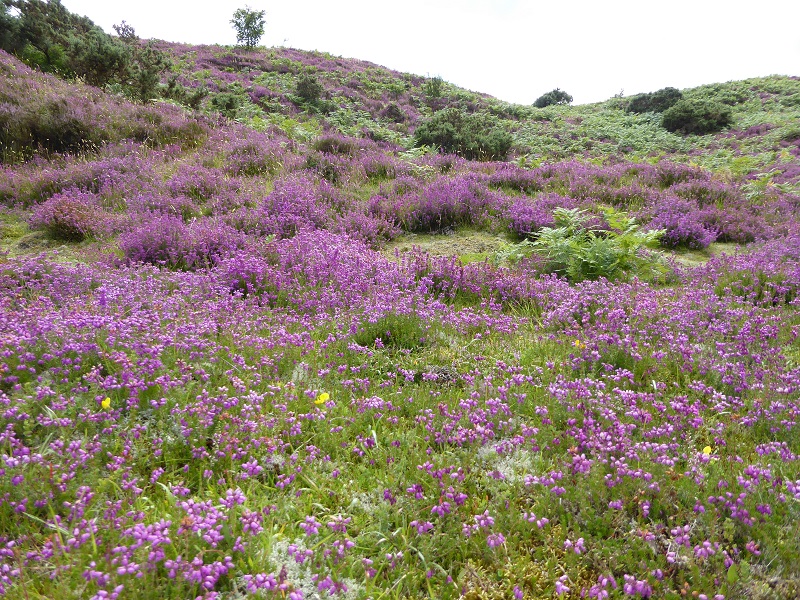 Murlough, County Down. Photo J.Harding.
Murlough, County Down. Photo J.Harding.
On 5th August BCI was at Murlough, County Down with members of Butterfly Conservation Northern Ireland (BCNI) and the Belfast Naturalists’ Field Club. The Murlough is a unique coastal heath just north of the Mourne Mountains which provide a stunning backdrop to the ancient dunes, adorned with deep purple Bell Heather. It is renowned for its butterflies too, and is perhaps the best site in Northern Ireland. We spent the full day there, lunching in the sun at the stable block. We saw the common butterflies especially on the buddleia at the stable block while on the dunes and grassland we found Small Coppers, Dark Green Fritillaries, Marsh Fritillaries (larvae), Graylings, Meadow Browns and Small Heaths. Sadly, there were no Walls, sadly now believed to be extinct in this part of Ireland. We express our thanks to BCNI for the invitation and warm welcome.
We will shortly have our events programme for 2018 on the BCI website. See you in 2018.
Crabtree Reserve Report 2017
| Species | 2011 | 2012 | 2013 | 2014 | 2015 | 2016 | 2017 |
| Dingy Skipper | 17[11] | 31[28] | 33[28] | 23[23] | 42[33] | 13[13] | 23[20] |
| Green-veined White | 49[45] | 41[26] | 106[86] | 58[40] | 46[38] | 11[03] | 14[10] |
| Orange-tip | 45[41] | 11[11] | 14[10] | 25[07] | 14[11] | 11[08] | 03[02] |
| Large White | 01[00] | 01[01] | 01[01] | 00[00] | 02[01] | 00[00] | 01[01] |
| Small White | 04[02] | 04[02] | 11[11] | 23[19] | 16[11] | 02[02] | 04[02] |
| Cryptic Wood White | 00[00] | 03[02] | 01[00] | 09[06] | 05[03] | 08[08] | 06[05] |
| Brimstone | 14[05] | 36[14] | 53[21] | 44[26] | 58[32] | 56[19] | 47[23] |
| Common Blue | 81[74] | 68[61] | 54[52] | 60[46] | 65[62] | 13[09] | 39[36] |
| Small Copper | 18[17] | 23[10] | 17[08] | 08[02] | 17[07] | 16[01] | 08[05] |
| Red Admiral | 26[05] | 08[01] | 07[01] | 67[14] | 26[11] | 43[11] | 120[88] |
| Painted Lady | 00[00] | 01[01] | 02[00] | 01[01] | 03[02] | 93[54] | 20[09] |
| Small Tortoiseshell | 58[26] | 315[140] | 335[296] | 50[30] | 88[60] | 248[142] | 66[47] |
| Peacock | 22[13] | 168[53] | 233[123] | 111[79] | 76[30] | 212[56] | 241[128] |
| Dark Green Fritillary | 00[00] | 00[00] | 00[00] | 01[01] | 01[01] | 05[04] | 04[04] |
| Silver-washed Frit. | 01[01] | 04[00] | 07[03] | 22[08] | 03[01] | 14[06] | 14[07] |
| Marsh Fritillary | 15[09] | 19[08] | 41[25] | 92[83] | 32[17] | 14[09] | 17[10] |
| Ringlet | 185[125] | 154[104] | 550[405] | 685[519] | 277[212] | 238[183] | 295[209] |
| Wall | 01[01] | 01[01] | 02[02] | 06[02] | 01[00] | 00[00] | 00[00] |
| Speckled Wood | 07[03] | 49[04] | 38[08] | 30[06] | 15[03] | 36[18] | 46[23] |
| Meadow Brown | 62[48] | 180[126] | 303[250] | 204[149] | 183[140] | 124[91] | 118[76] |
| Small Heath | 88[70] | 122[100] | 231[199] | 229[155] | 131[109] | 62[48] | 61[51] |
| Large Heath | 01[01] | 01[01] | 00[00] | 00[00] | 00[00] | 00[00] | 00[00] |
| Site Total | 695 | 1240 | 2039 | 1760 | 1101 | 1208 | 1147 |
| Counts | 25 | 25 | 26 | 24 | 26 | 21 | 19 |
| Ave Temp Celsius | 15.64 | 16.40 | 17.69 | 17.50 | 16.15 | 18.19 | 16.80 |
The butterflies on Crabtree Reserve Lullybeg are counted by walking the transect route on part of the reserve from April to the end of September. These results are sent to the National Biodiversity Data Centre. Butterflies seen outside the transect route are counted separately. Both counts are reflected in the table; the figure outside the brackets represent all butterflies counted while figures inside the brackets are transect counts.
There were fewer counts in 2017 which almost certainly accounts for the totals being lower than four of the previous six years. There were only two counts in April and three in May accounting in part for lower numbers of some spring flying butterflies such as Orange-tip and Green-veined White. However, the Green-veined White showed in low numbers in its second brood in July, suggesting a small first brood. A butterfly that seems to show a genuine increase on the reserve is the Common Blue; this butterfly likes a lower, more open sward; the reduction of the sward height and density caused by the cattle grazing and mechanical disturbance in 2016 led to a rebound in its fortunes in 2017. Another butterfly in low figures, the Marsh Fritillary, is showing recovery following the onslaught of the 2015 fire. Sadly, we found no Wall Brown on the reserve in 2017. The demise of this once common butterfly throughout Ireland is alarming and recent interventions have not enticed it back. The Small Heath was down in numbers too, reaching its lowest level in six years 2011-2016. Again, the breaking down of the dense, rank sward should help this species which feeds on fine-leaved grasses.
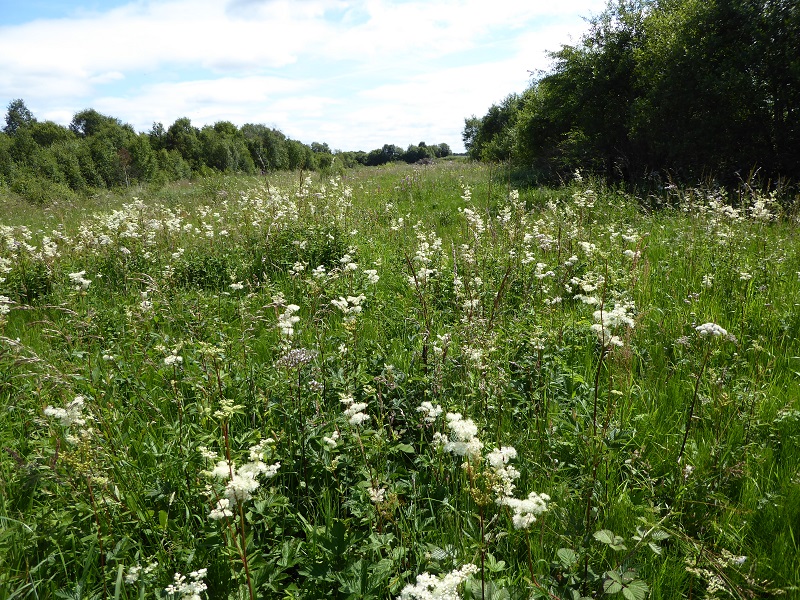 The south side of Lullybeg Crabtree Nature Reserve, cleared by machinery in 2016.
The south side of Lullybeg Crabtree Nature Reserve, cleared by machinery in 2016.
Two species that showed in record numbers in 2017 are the Peacock and Red Admiral. Small Tortoiseshell was down reflecting a bad September. Silver-washed Fritillary were in similar numbers to 2016 while Speckled Wood showed an increase. The Painted Lady showed its second highest numbers in the seven years but did not come near its bumper year in 2016. The Ringlet did well but again the Meadow Brown was not very successful, with only 2011 showing lower numbers. A positive sign is the return of the Dark Green Fritillary; both males and females were seen and it is hoped that the violets growing up through the taller grasses and at the edge of scrub will prove to be good breeding ground for this magnificent species. A female, believed to be laying eggs, was seen on violets on the southern side of the reserve.
Finally, we record our special thanks to our grazing donor and to Bord na Móna for assisting with sward reduction, and poaching and heavy scrub clearing and ground disturbance respectively in 2016, which helped to maintain the site’s habitats. We thank our members and friends for your work in scrub-cutting and uprooting. Ongoing management work is crucial to conserve this magnificent site, and the hard work is richly rewarded when we get to enjoy the butterflies there from March to October.
Conservation News
Conservation is a major part of our remit and 2017 saw important work. In February and November, a Butterfly Conservation Ireland (BCI) work party cleared scrub on grassland at Lullybeg to create the conditions needed for the Marsh Fritillary, Dingy Skipper and Brimstone. Scrub on the broad ride through woodland connecting Lullymore and Lullybeg was also cut back to ensure that the two excellent areas remain linked so that butterfly populations in the area do not become isolated. Our project site in the Burren at Fahee North, Co. Clare received attention with a scrub cutting day in late September near the centre of the site to make sure the area is not cut in two. Grazing took place on the site in summer. Grazing helps to maintain the high-quality habitats on this land.
Our recording scheme begun in 2013 continued in 2017. However, the website was hacked so badly it had to be reconstructed, which required considerable, currently ongoing effort. The closure of the butterfly recording scheme operated by the Dublin Naturalists’ Field Club meant that we received a great increase in the number of records, which is most welcome. Calls for conservation must be supported by good information which will help us to make the case for the conservation measures needed.
Our website was used to promote conservation throughout 2017. We reported through our Facebook page the inappropriate mowing at the height of the flight season of c.1km of flower-rich habitat at Ticknevin, County Kildare. Within 24 hours over 11,000 visits to this post were recorded, highlighting public anger at this senseless damage. Waterways Ireland contacted BCI to explain the context but this explanation was not accepted. BCI continues to liaise with Waterways Ireland regarding habitats associated with inland waterways. We met representatives of Waterways Ireland and Meath County Council to highlight the threat to areas of rich butterfly habitat between Enfield and Cloncurry and a design was agreed to avoid encroachment on the areas of high biodiversity value. BCI met the contractor and a representative of Meath County Council during the works to verify that the agreed design was being adhered to and resolve any issues arising. The result of this work is the creation of a hard surface that does not damage the breeding sites of the Dingy Skipper and Cryptic Wood White. However, the atmosphere associated with the waterway is, in our view, altered by the works and the bucolic gentleness associated with original grassy pathway is lost.
BCI also made submissions to three local authorities in Kildare, Laois and Carlow concerning Waterways Ireland’s plan to install hard surfaces along the Barrow and Grand Canal. BCI was involved in a vigorous campaign online and in the broadcast and print media, including The Irish Times in relation to this issue. The development will certainly remove valuable butterfly habitat, including an area use by a strong population of the Comma butterfly. The councils called for extra detail which Waterways Ireland has now submitted. We will examine this and make fresh submissions.
In 2015 The Department of Arts, Heritage and the Gaeltacht carried out a review of Section 40 of the Wildlife Act that deals with the closed season for hedge cutting and scrub removal and the season for burning vegetation in upland areas currently March 1 to August 31. We recommended retention of the closed season. Minister Humphreys ignored the advice of Butterfly Conservation Ireland and several conservation NGO’s and tried to change the law to allow hedge cutting in August and burning of vegetation in upland areas into March in the Heritage Bill 2016. Many moth larvae feed on hedges during August. During March many butterfly and moth larvae begin/resume feeding/basking on upland vegetation. BCI expressed its opposition directly to Minister Humphreys and wrote a submission concerning the impact of the proposed changes on butterflies and moths for BirdWatch Ireland to use in its campaign. The minister is having trouble in getting the legislation amended, a tribute to the opposition the proposals have generated. The controversial Section 8 of the Heritage Bill was discussed by an Oireachtas committee and an updated written submission restating our views was made in December 2017. We await the outcome of this committee’s deliberations.
BCI also made submissions to the Maynooth Biodiversity Action Plan, made a presentation in May at National University of Ireland Maynooth (NUIM) for Biodiversity Week on habitat creation for lepidoptera. BCI also met Dr James Carolyn from the Biology Department at NUIM and Stephen Seaman, the university groundman to advise on biodiversity improvements to the campus. Arising from these contacts, a wild flower grassland was sown. Acorns from the ancient oaks from Charleville, Tullamore were supplied to Stephen for sowing and eventual planting on college ground.
In December 2017 Jesmond Harding represented BCI at a meeting which discussed the ongoing work on the all-Ireland butterfly atlas in 2022. Butterfly Conservation Northern Ireland, the National Biodiversity Data Centre and members of the Dublin Naturalists’ Field Club acting in their own capacity were also present. We will meet again in early 2018 to discuss progress.
 Small Blue, female basking on Kidney Vetch. Photo J.Harding
Small Blue, female basking on Kidney Vetch. Photo J.Harding
We conclude this review with a success story. In 2014 Small Blue butterflies were introduced to highly suitable habitat in County Meath. Most of the site that the butterflies were taken from has since been destroyed by coastal erosion. In June 2017 the receiver site was checked. The results have been excellent to date, with a thriving population now established there. It is heartening to see this endangered species benefiting from a helping hand.
Please continue your recording and conservation work in 2018; no matter how small your work may seem you can make a difference. Some man-made habitats, such as gardens, often contain a greater range of biodiversity than semi-natural habitats because of the diversity of habitats and micromanagement possible in a garden.
Finally, BCI thanks everyone who helped with our conservation work in 2017. Conservation is a battle for the preservation of everything that is good about our natural world and we greatly appreciate your commitment to the most elegant emblems of our natural heritage, our butterflies and moths.
Garden Survey Report 2017
Butterfly Conservation Ireland members and members of the public participated in our garden survey from March to November inclusive. The survey form, available as a download from our website www.butterflyconservation.ie and available by post on request asks the participant to record the first date each butterfly listed on the form was first recorded in their garden in each of the following three-month periods: March-May, June-August and September-November. In a final column, the highest number of each butterfly seen and the peak date is given. Finally, surveyors are asked to indicate which of the following attractants are provided in their gardens: Buddleia, butterfly nectar plants other than Buddleia and larval food plants. Twenty butterflies are listed for recording.
Comments received were not especially positive for 2017. No surveyor reported very high numbers; the highest number of butterflies counted in one day in 2017 was 28 (25 in 2016) down from 50 butterflies on one date in 2014. August and September did not see the numbers expected due to the rain during these months. Conditions improved late in September but the main flight season for most butterflies that visit gardens has passed at this stage. A notable feature was that reports of Red Admiral were up on previous years.
The total number of species recorded in the gardens surveyed was 15, up on 14 in 2015 and 2016, but down from 17 in 2014. The Green-veined White, Small Tortoiseshell and Peacock were recorded in all gardens while the Holly Blue, a species that likes to breed in gardens was reported by just four surveyors, with Michael Gray from Rathfarnham submitting 43 records of the butterfly. The species with the highest number of individuals recorded on a single day is the Red Admiral, with 25 recorded by Jonathan Shackleton. The lowest number of records were for the Wall Brown (not listed on the survey form) and an unidentified skipper, either the Small or Essex Skipper, at one each. These are very unusual garden species records for Ireland. Both were seen by Jesmond Harding.
The Large White and Small White were seen in all but one garden. The Large White had a good year overall in 2017. The Holly Blue numbers have not reached the numbers found in the early 2000’s up to 2007. The dates that the Holly Blue was recorded indicate that two broods were produced in the east midlands in 2016; Pat Bell recorded the butterfly on 08/04 (first generation), and on 13/07 (second generation). Elaine Mullin’s garden in Portmarnock on the Dublin coast recorded two broods and 66 individuals. Elaine recorded the butterfly from March to May (first generation) and July and August (second generation). No third brood Holly Blue was recorded in any garden in 2017, 2016 or 2013 but there was evidence of a third brood in 2014 and 2015. Jesmond Harding found the Holly Blue breeding on Alder Buckthorn plants on a south facing patio. No Cryptic Wood White, Brimstone, Common Blue or Silver-washed Fritillary butterflies were reported in gardens in 2017 or 2016. The Ringlet was found in a number of gardens in rural areas mainly, but in low numbers. The Ringlet’s companion, the Meadow Brown, was found in higher numbers in our gardens while the Speckled Wood occurred in more gardens but in lower numbers than the latter which is typical for a territorial species. The Painted Lady featured in a number of gardens both urban and rural. The Red Admiral continued to favour flower and fruit-rich gardens. The highest number of Red Admirals reported was 25 on 30 August, by Jonathan Shackleton.
The earliest garden record was of the Small Tortoiseshell on 15/03 (recorded by Paul Cutler, County Carlow and Jesmond Harding, County Meath). The latest was the Red Admiral on 17/10 by Pat Bell, County Kildare. The urban/suburban garden with the highest number of species recorded was that of Pat Bell in Maynooth with 12 butterfly species; the highest for the rural gardens was Jesmond Harding’s with 15 species. Other interesting records were of dragonflies and moths with Pat Bell recording Brown Hawker and Migrant Hawker dragonflies and Cinnabar, Hummingbird Hawkmoths and Silver Y moths in his garden. Ann Baskett had a beautiful Brimstone moth on a brick wall.
Gardens that provide both larval food plants as well as nectar sources had significantly higher numbers of species than those that provided nectar only. This finding is important because it suggests that butterflies can use gardens for their full life cycle, and that gardens have a role to play in conservation. Growing Stinging Nettles, cabbages, Common Bird’s-foot-trefoil, Lady’s Smock and wild grasses in sunny, sheltered conditions is a great draw to butterflies and moths. Growing Alder or Purging Buckthorn, Common Holly and native ivy will enrich the species count and numbers further. One may really be inspired to go still further by offering bruised over-ripe plums or dates which Red Admirals find irresistible.
Gardens with Buddleia had high numbers of butterflies, and the plant is especially attractive to the Large White, Small Tortoiseshell, Peacock and Red Admiral.
We appeal to gardeners not to grow invasive non-native flowers, no matter how attractive these are to insects. It is worrying to see the damage to natural habitats being done by non-native plants like Red Valerian, Montbretia and the various cotoneaster species. These are invasive plants that overwhelm natural vegetation and the problems that they cause can be seen in parts of the Burren, the sand dunes at North Bull Island, Donabate, Baltray and elsewhere. Finally, we make a plea to all gardeners to avoid the use of chemicals in the garden. Although this is not fully proven there is strong evidence that pesticides may be killing huge numbers of insects, even non-target species. Water soluble chemicals that are absorbed into plant tissues make their way into pollen and nectar, affecting bees, moths, butterflies and other insects that visit flowers. Let your garden be a genuine wildlife garden where give-and-take prevails, and where your wild creatures are safe from poisoning.
Get Involved
We hope to expand the garden recording scheme further in 2018. Our website www.butterflyconservation.ie contains information about butterfly gardening; click on the “Butterflies” tab and select “Gardening for Butterflies” for details. The survey form can be downloaded from here but if you need a hard copy please request one by emailing us at conservation.butterfly@gmail.com or by letter to Butterfly Conservation Ireland, Pagestown, Maynooth, County Kildare. If you have any doubts about the identity of any butterfly check our Gallery by clicking on the “Butterflies” tab. Thank you for taking part in the scheme and please continue your recording. Recording begins again in March and here’s hoping for a good season in 2018.
Red Admiral Mark and Release Project in Pat Bell’s Garden 2017
By Pat Bell
Background
I always get Red Admirals in my garden at the end of summer but the last three years saw quite a jump in numbers. I grow a lot of fruit and they particularly like hanging around in the fig tree in my back garden and they love the windfall plums which I have been putting out for them in recent years. One question which recurs for people like myself who encourage and delight in butterflies in their gardens is, am I seeing the same individuals? Recent individuals to catch my attention were one late ‘hanger-on’ last autumn and one pristine specimen which appeared in my conservatory in May this year. The only way to answer this question as far as I could see was to catch and mark some and see what happens.
Another incentive was on learning of the Red Admiral migration project being undertaken by Marco Thoma of the University of Bern (www.insectmigration.wordpress.com/red-admiral-migration/). Our National Biodiversity Data Centre (NBDC) was one of the first partners to sign up to this project and will forward data to Marco. With this in mind I uploaded five years of my garden records (2012-2016) which was gratefully acknowledged by both parties.
Catching
Red Admirals started turning up in mid-June which was a good two months earlier than usual. They were mainly occurring on the summer buddleia in my front garden so I started catching them with my regular butterfly net and marking them with highlighter pens. I then acquired a butterfly trap and a set of marking paints from wildlife and ecology specialists NHBS. I set it up with a tray of bait in my back garden on 12th July.

There are numerous recipes out there for baiting traps many involving concoctions of bananas, molasses and maybe even a shot of rum. However, as I started having immediate success with overripe bananas I just stuck with soft fruit. I supplemented these with figs when they became available and these always prove irresistible to Red Admirals. Interestingly, they didn’t attract their Irish Vanessid cousins Peacocks or Small Tortoiseshells. I observed very few escapees as their tendency was to fly up to the top of the trap where they would roost in the evening if I hadn’t removed them.
Marking
There are numerous marking systems possible. Marco Thoma simply stained the white tips of the forewings using different colour codes in September 2016 at two Alpine passes through which Red Admirals migrate southwards. He informed me that they’re not using country codes but are planning to use numbered tags for autumn 2017. Matthew Oates in his book ‘In Pursuit of Butterflies’ makes reference to the clock method whereby each butterfly is given its own unique number by placing two small dots on the wing undersides. I opted for applying unique numbers to the underside of both wings using marking paint. I also started using a different colour each week to facilitate identification from a distance and I recorded and photographed every individual before release.

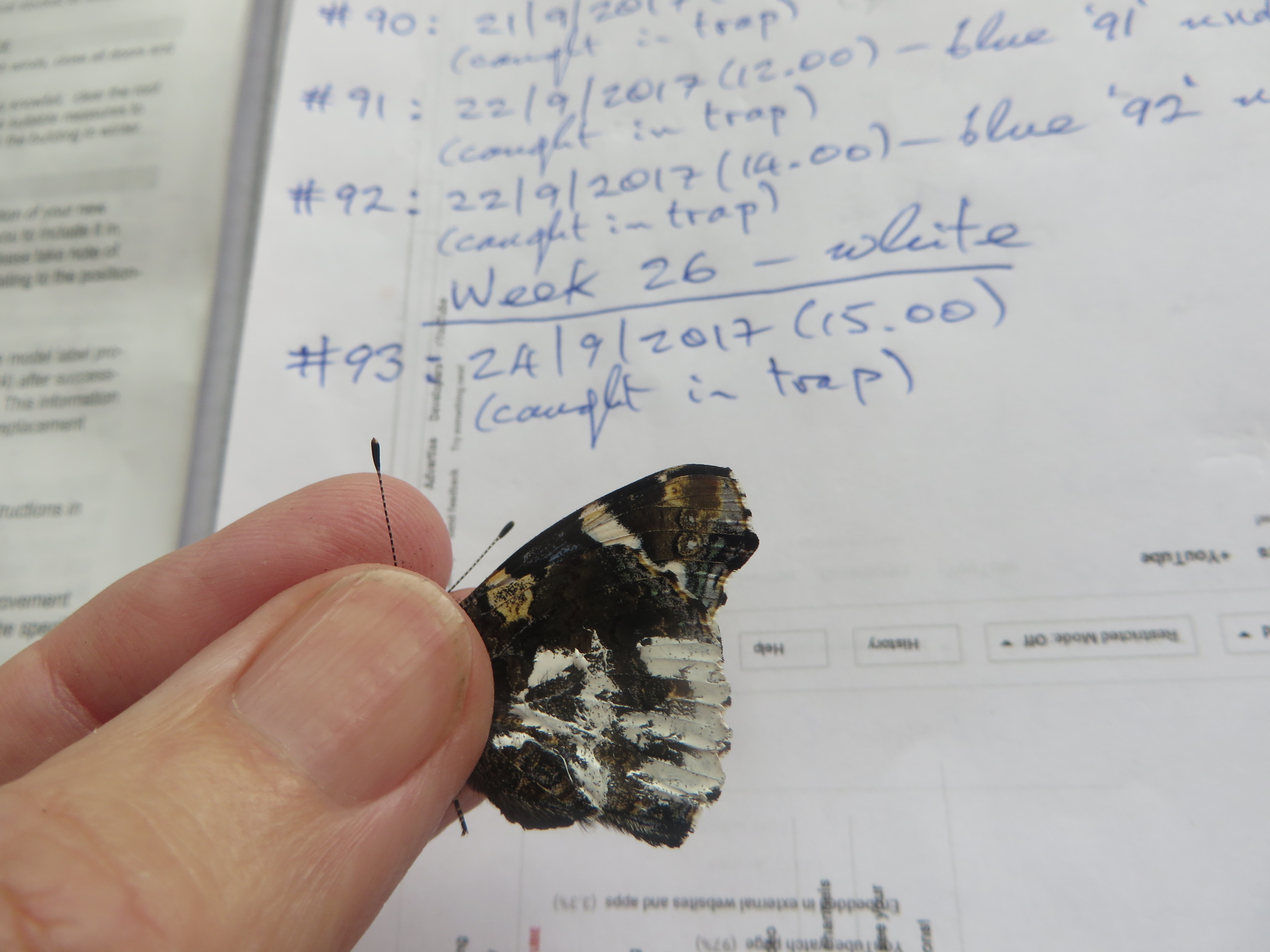
Releasing
I released them into my conservatory with a view to giving them an opportunity to recover from any trauma although in reality it didn’t seem to bother them too much. They were free to leave the conservatory through open windows and vents and the door was open a lot during the day. My observations were that if they were released earlier in the day then they would generally depart that day. However, if released later in the day or if the weather wasn’t great then they would typically stay one night in the conservatory before departing the next day if the weather was favourable. When overnighting they tended to roost on the underside of a vine leaf or on a bunch of grapes.
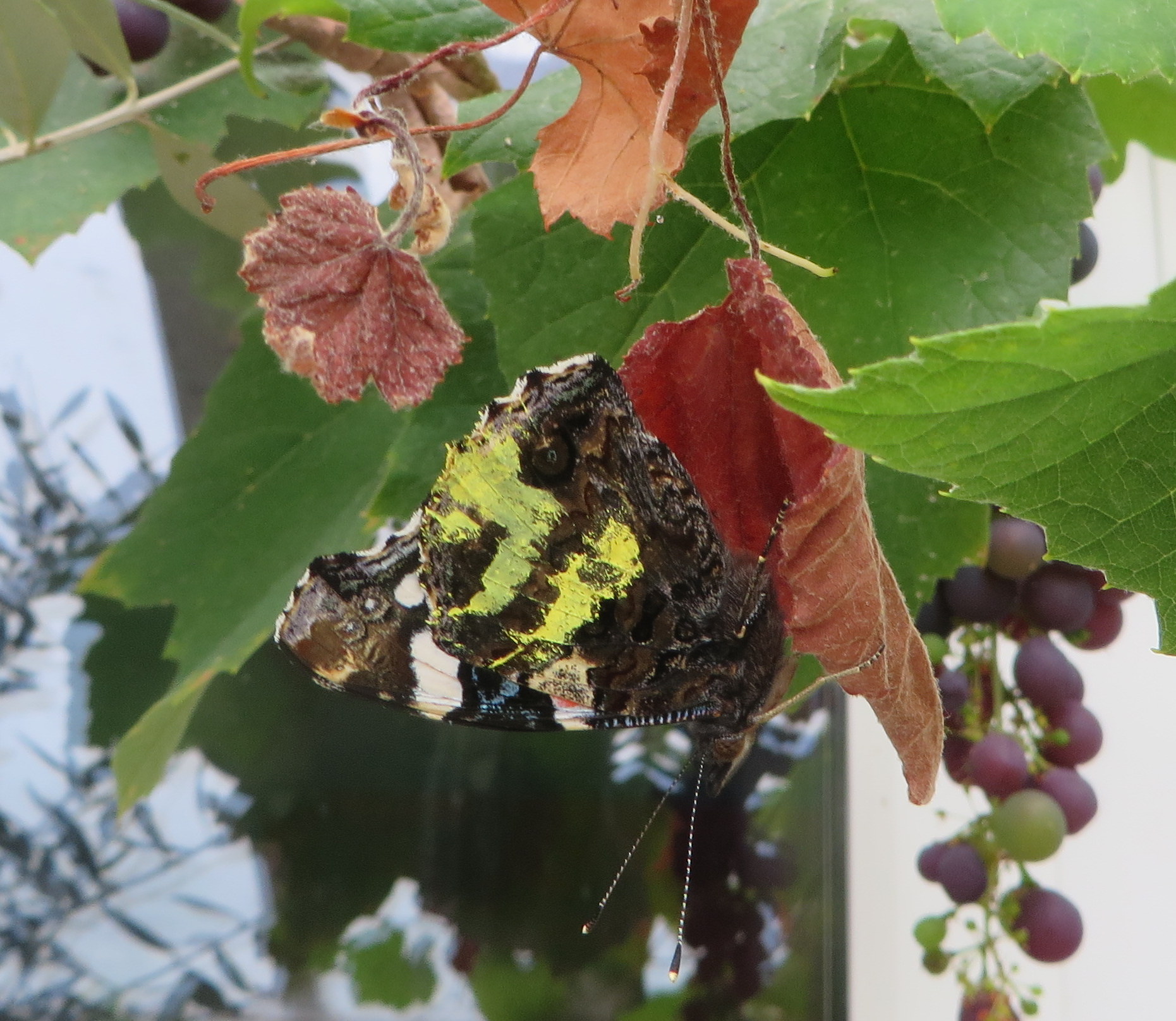
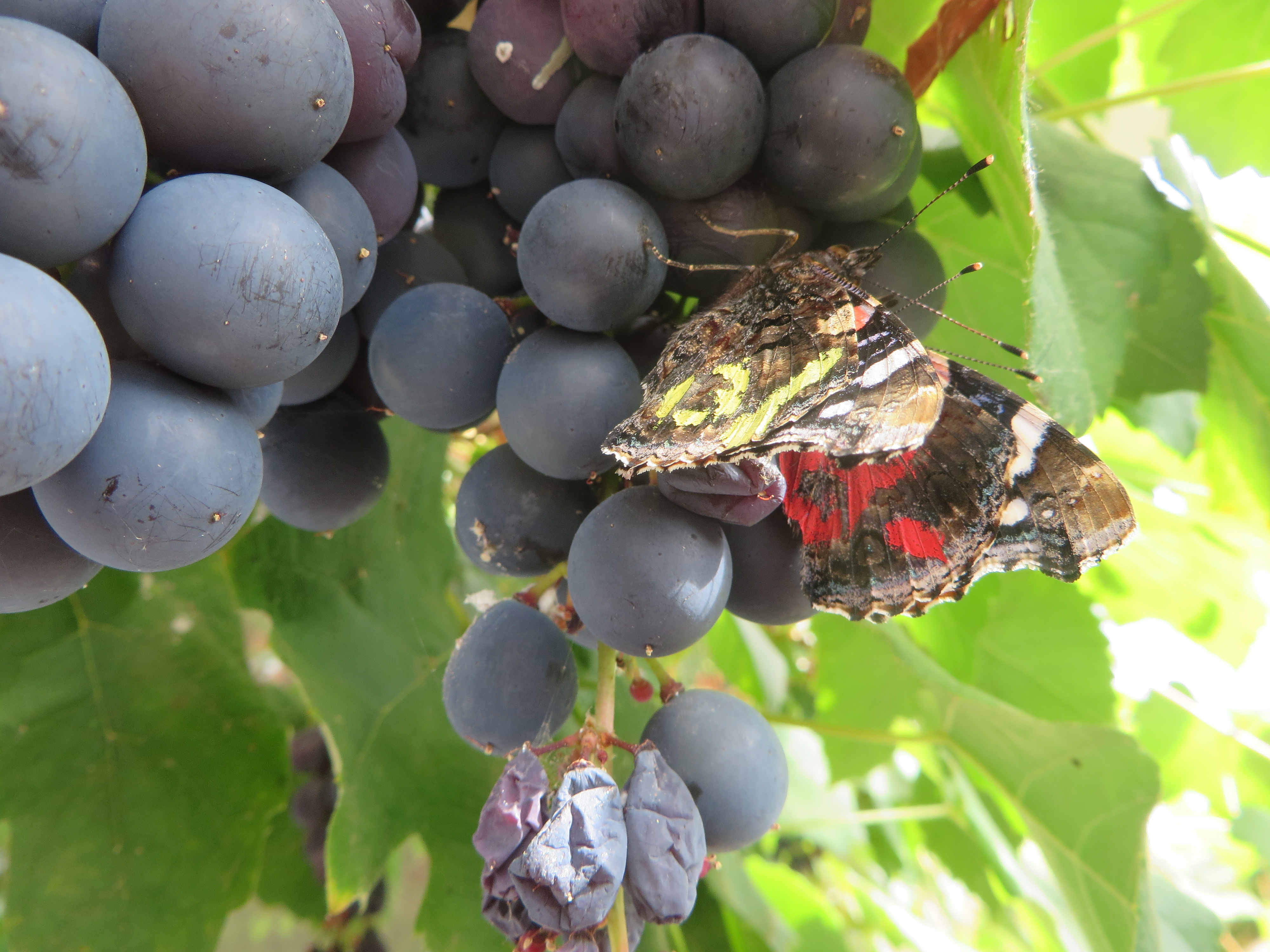 Released individuals. Photo Pat Bell.
Released individuals. Photo Pat Bell.
Results
In total I caught and marked 95 individuals; the most in one day was seven on 8th September; the most in one week was 16 in Week 23 (2-8 September). The AM:PM split was 56:44 but, as I was more likely to be around before midday (GMT), I don’t think this is significant. Of the 95 caught, I only recaught two not counting the occasional one that went straight back into the trap on release. This was the most outstanding and surprising aspect of the whole exercise from my point of view.
I count butterflies in my garden every year using Birdwatch Ireland’s methodology whereby each week I take note of the highest number of butterflies of each species that I see. Using this methodology, the highest total of Red Admirals recorded in my garden was 42 in 2016 with over 80% of this occurring in four weeks from mid-August. I estimated 62 for 2017 using the same methodology, with over 80% occurring in nine weeks from late-July. This is well short of the 95 actually caught. There are various methods for estimating population size using mark and recapture techniques but they don’t apply directly to my exercise as I wasn’t taking a rigorous scientific approach. Nevertheless, as smaller recapture rates indicate larger estimates of population size, I think my results point to a much larger population of Red Admirals in the vicinity of my garden than counts would indicate.
Conclusions
I didn’t expect to catch so many, although it was an exceptionally good Red Admiral year, and I didn’t anticipate the extremely low recapture rate. It was quite time consuming and most of the activity seemed to occur when the sun came out just as I was just about to go to one of my transects! If I do it again in 2018 it will be a reduced effort with minimal recording and photographing and I will just use a simple colour marking system as the numbers recaptured were extremely low.
Garden Moth Survey
By Don Hodgers.
Butterfly Conservation Ireland runs its own National Garden Butterfly Survey Scheme the findings of which are described in this report. Our mainly nocturnal moths need to be surveyed too and the garden at Butterfly Conservation Ireland’s registered office is used to survey moths. In this article Don Hodgers, the Irish co-ordinator of a survey that is run in Britain and Ireland describes the aims of this survey and calls for new entrants…
The Garden Moth Scheme is a Citizen-Science project that involves a systematic survey of common garden moths, carried out once a week. The main survey runs from March to October but some recorders also take part in a winter survey from November to February. The survey started in 2003 in the UK and there are now some 317 gardens surveyed throughout the UK and Ireland. Ireland became involved about ten years ago, and after a slow start, twenty-four sites are now involved. The aims of the survey are to increase interest in our common moths, to study trends in their density and distribution, to build up a database of records and to make this database available for study by researchers. The 2013 report on ‘The State of Britain’s Larger Moths’ showed worrying declines in the numbers of moths, with iconic species such as Garden Tiger, Arctia caja, declining by 92% over forty years and Double Dart, Graphiphora augur, by 98%. Other species, however, have benefitted from recent climatic and other changes – Blair’s Shoulder-knot, Lithophane leautieri, first recorded in Ireland in 2002, increased by 7,878% over the same period. Change is happening to our garden moths – the Garden Moth Scheme is helping to document that change.
 The Double-dart declined by of 98% over forty years according to a 2013 report. Photo J.Harding.
The Double-dart declined by of 98% over forty years according to a 2013 report. Photo J.Harding.
And more recorders are needed to help do that work! At present Co Dublin has five GMS sites, Antrim, Louth and Wicklow have three each, Leitrim and Westmeath have two each, and Cork, Derry, Donegal, Fermanagh, Mayo and Meath have one site each. So all but one of the present set of recorders are based north of a line from Mayo to Wicklow.
Not all of our garden moths are tracked in the survey – only about 230 of the most familiar and relatively easy-to-identify species. In this way, the survey is suitable for all recorders from beginner to experienced. And identification help is available. Most recorders in fact, do choose to record a supplementary list of the other species that they obtain.
2017 was not a vintage year for moths, but nevertheless Irish participants gathered some eight thousand records, involving over twenty-eight thousand moths in the summer GMS survey. In addition, 1,300 records of non-GMS species were reported, involving three thousand other moths. As well as the common species, some scarce moths turned up during the year, including two Lime Hawk-moths, Mimas tiliae, following on from an earlier GMS record, and Ireland’s only record so far of Ruddy Streak, Tachystola acroxantha. Thanks is due to all the GMS recorders for this great effort.
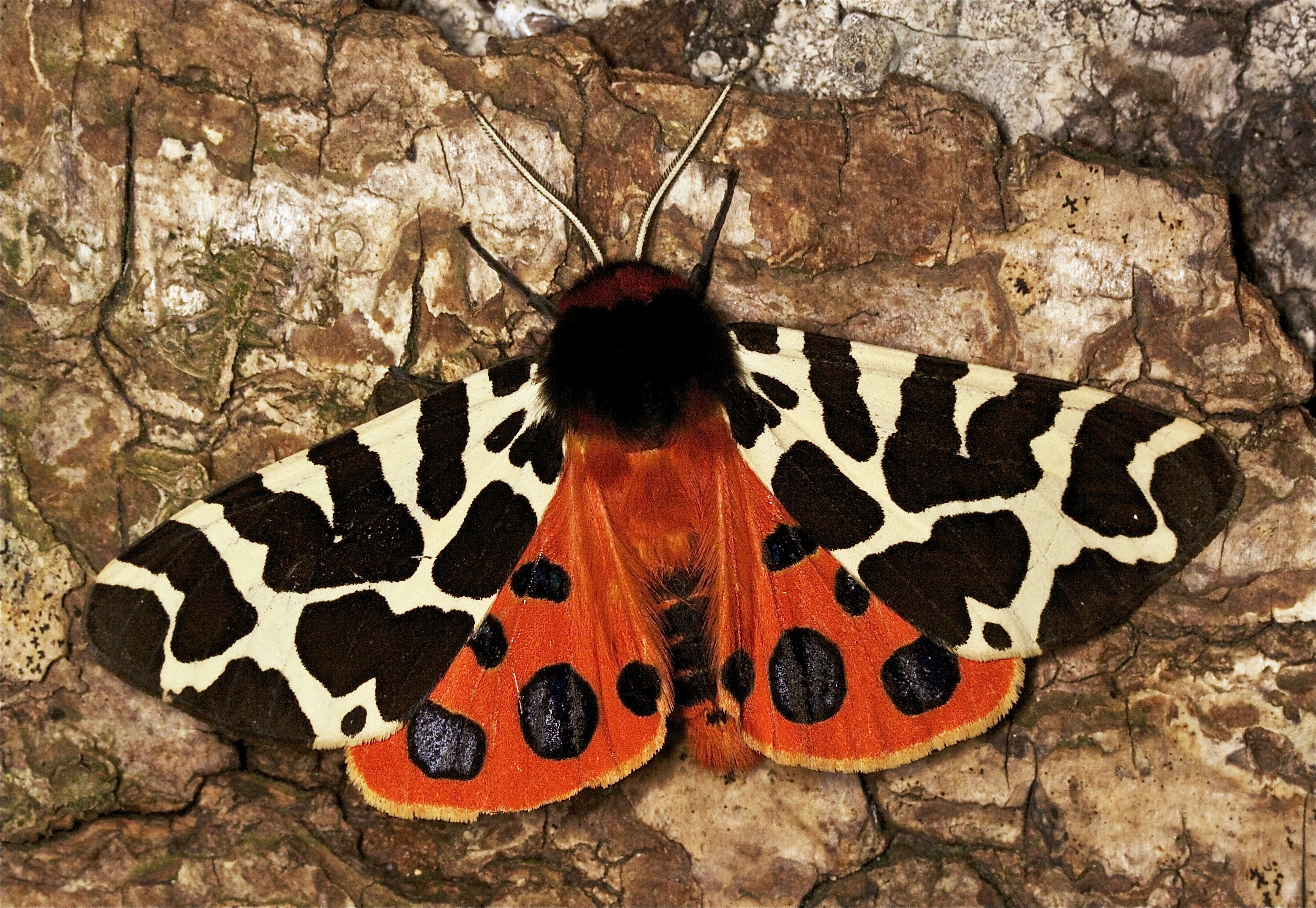 Garden Tiger. Photo Don Hodgers
Garden Tiger. Photo Don Hodgers
But it’s not a competition to find out who has the best garden or the most moths, or the scarcest species. All the information helps to paint the picture – from small urban patches to gardens in prime rural habitat. What is important is the regular, sustained effort, so that even empty traps, often the case in winter and early spring, provide important data. Records are then centralised, processed and made available for study, and an interim analysis is reported to recorders. Scientific papers, based on the data, have been published on habitat and climatic factors, and another on the role of artificial night-time lighting is in preparation.
There are many non-GMS recorders out there who regularly trap in their gardens anyway, and who would be most welcome to join the scheme. And help is always available for those just starting out. Researchers today in many fields of science are very grateful to those in the past who took the time and trouble to record and submit their findings. GMS recorders today are building up a valuable database for future researchers and we can be sure they will be very appreciative. It can be disappointing at times to find empty traps, but then again there are so many more wonderful mornings to keep us hooked! Further details, including contact details, are available on the GMS website at http://www.gardenmoths.org.uk/
Hedge Brown /Gatekeeper Pyronia tithonus
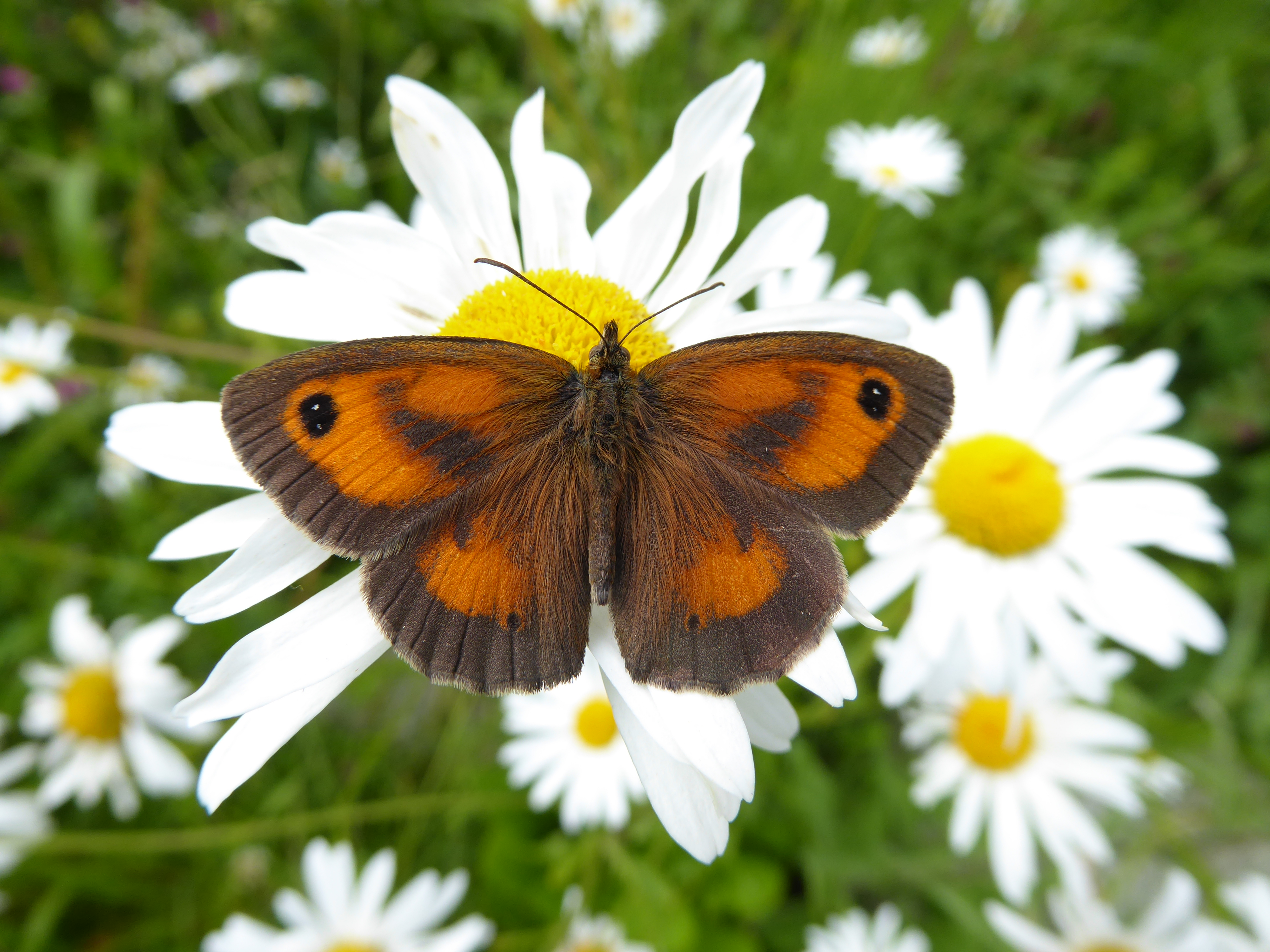 Male Hedge Brown (bred specimen) basking on Ox-eye Daisy.
Male Hedge Brown (bred specimen) basking on Ox-eye Daisy.
DESCRIPTION: The Hedge Brown butterfly is also called the Gatekeeper. Its upperwing surfaces are brown with rich orange patches. The female’s forewings have a clear, large orange patch, while the male’s forewings have a clear brown patch containing androconia (scent scales) extending into this orange patch from the base of its forewing. The male is noticeably smaller, measuring 44mm across the forewings, while the female can measure up to 48mm. In overall appearance it resembles a Meadow Brown but is noticeably smaller and brighter.
HABITAT: The species is nearly always associated with scattered scrub, bracken or native hedgerow with wild grasses growing at the edges. It also inhabits open woodland, like that found at The Raven, County Wexford. The sward used for breeding is typically well developed and lightly grazed, occasionally grazed or ungrazed but subject to some disturbance.
FLIGHT TIME AND BROOD STRUCTURE: It is on the wing from late July to early September.
BEHAVIOUR AND LIFE CYCLE: Males patrol along pathways near hedges or along hedges and turn at a certain point and retrace their flight path. It has a bobbing but somewhat erratic flight with the rich orange upper surfaces a prominent distinguishing feature. Despite being the more active sex, males appear to be highly sedentary; two males patrolled a five-metre length of hedge in my garden for four days before they dispersed or were predated. Females spend more time perching, basking and feeding on nectar. Despite flying less frequently, females probably move longer distances. On warm, sheltered sites they can reach enormous numbers, feeding during hot conditions on Creeping Thistle, Common Ragwort and bramble. They often congregate to feed on flowers growing at a break in a hedge or where a long hedgerow with flowering bramble ends and is adjoined by tall wild grassland. The butterflies vanish when the sun disappears and seek out the underside of bramble leaves. When heating up after a cloudy period, both lateral and dorsal basking is used.
Egg laying is inconspicuous, and one reason is that eggs are simply ejected in flight. They are dropped where grass clumps adjoin patches of scrub or hedgerows. However, sometimes eggs are placed very carefully but unobtrusively; on 28th July 2015 I observed egg-laying on sand at the base of a fescue grass, either Sheep’s Fescue or Red Fescue. The female crawled slowly to the foodplant, curved her abdomen near the base, laid an egg, moved a short distance, repeated this procedure and flew away. The ovum is very small; pale cream, barrel-shaped and non-adhesive. Three eggs were found on dry, dead blades at base of Sweet Vernal Grass Anthoxanthum odoratum, and one on a green stalk at base of this grass. No eggs were laid on or near False Brome Brachypodium sylvaticum.
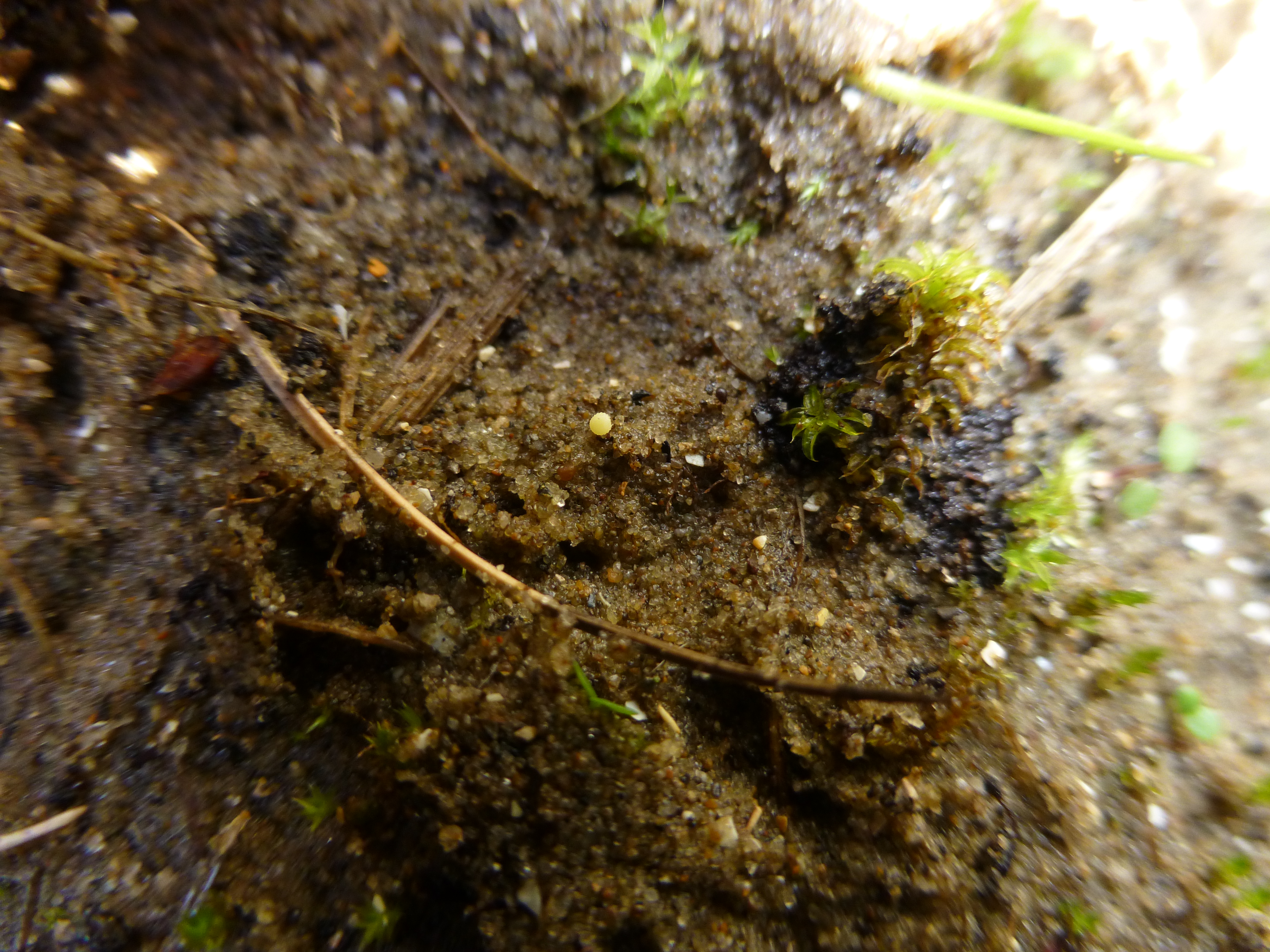 Hedge Brown egg.
Hedge Brown egg.
The egg stage observed lasted c.13 days. The larva eats the egg shell. Feeding during the day occurred during the autumn even during cold (4C) but sunny conditions. The second instar larvae fed on the tender tips of the grass blades. On 20th December a larva that was observed feeding outdoors during sunny, breezy conditions (10C) measured 8mm. At this stage it was green with bristles prominent on head and body. The head was pale brown with a darker brown blotch near the biting mouth parts.
No activity was observed between 20th December and 6th March 2016 when feeding resumed. On 11th March 2016 a larva observed measured 6mm, suggesting some shrinkage arising from its long fast. From mid-April feeding was strictly nocturnal, no doubt to reduce the chances of predation from birds. During the day larvae rest at the base of grass tussocks.
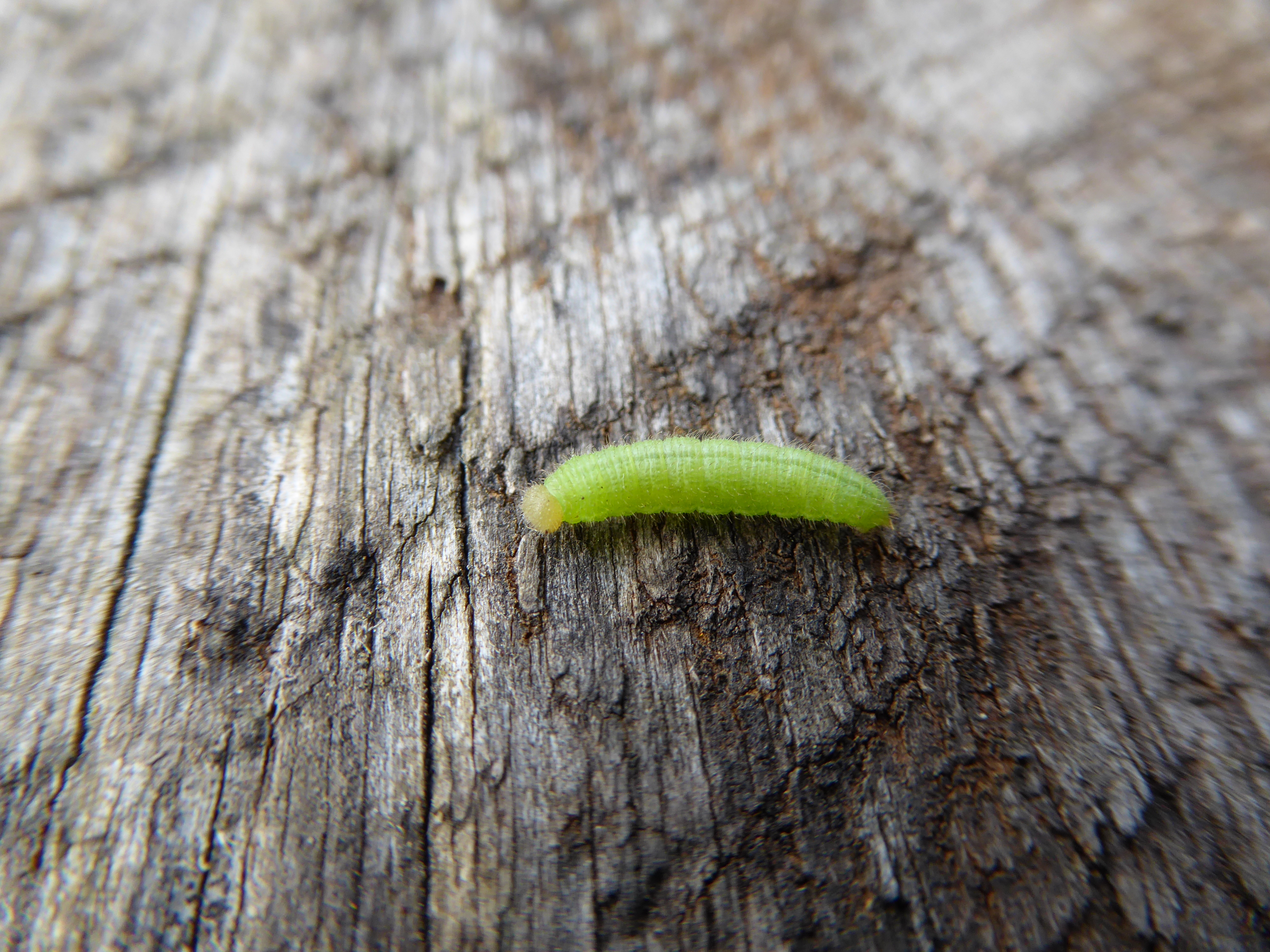 Fourth instar Hedge Brown larva.
Fourth instar Hedge Brown larva.
On 15th April larvae measured 10mm; the body was mid-green, covered in white bristles with a darker green dorsal stripe and a white lateral stripe extending to and almost continuous with white anal points. The head was pale olive-brown. On 16th April night feeding was observed in calm conditions with near freezing temperatures. Larvae blend superbly with the foodplant even when feeding at night.
At this stage larvae show a keen sensitivity to light levels, and begin to feed only when it is nearly fully dark. On 18th April one larva was seen at 9pm and three at 9:20 pm when it was nearly fully dark; the temperature was 9C. At 5am, when still dark, larvae were feeding but just before dawn the larvae descended to the dense base of the host-plants. As daylight levels increase larvae delay feeding until later in the night; on 26th April larvae began to feed later, at 10:30pm; while on 28th April larvae (one measured 12mm) delayed feeding until 11pm, feeding during a light, cold breeze with the temperature at 2 Celsius.
On 19th April eight larvae were observed; at this stage most were on Sweet Vernal Grass, a broad-bladed grass which provides more bulk than the finer-bladed fescues.
After an inter-moult stage lasting about six days (this is a long time for moulting larvae) the larvae were seen again on 9th May; these measured 12mm, these were now in the fifth and final instar. All had moulted from green to brown. According to Heath et al. 1990 both brown and green colour forms exist in the final instar.
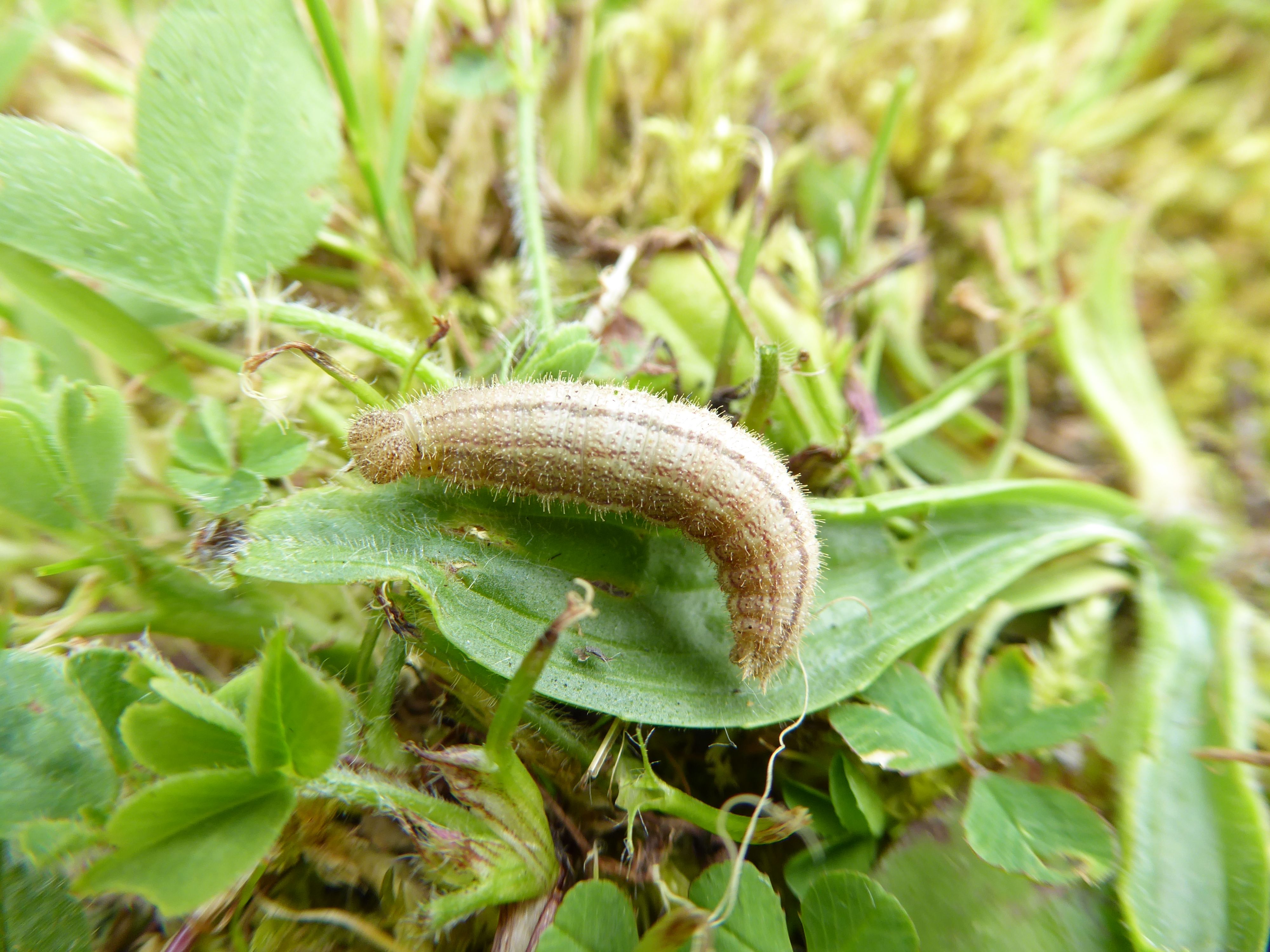 Fifth instar Hedge Brown larva.
Fifth instar Hedge Brown larva.
Fully-fed larvae reached 20mm when hunched up and 25mm when extended. When feeding, larvae are sedentary. Larvae still fed high up on foodplants; blades were eaten from the edge and tip. The pupation of the larvae occurred between 10th June and 20th June. The larval stage lasted c.310 days.
The pupae were found in two situations; attached head down to a dead grass stalk low down on the foodplant or loose on the soil. Overall the pupa is off-white with strong black streaks on the wing cases and thorax while the abdomen contains two parallel rows of black blotches. On the ventral surface the antennae are picked out in black and white while two parallel black lines are located on either side of the thorax. The pupa has a dumpy appearance. Its colouring allows it to blend in with the bleached senescent grass tussocks. The pupae were 10-12mm in length and showed no mobility.
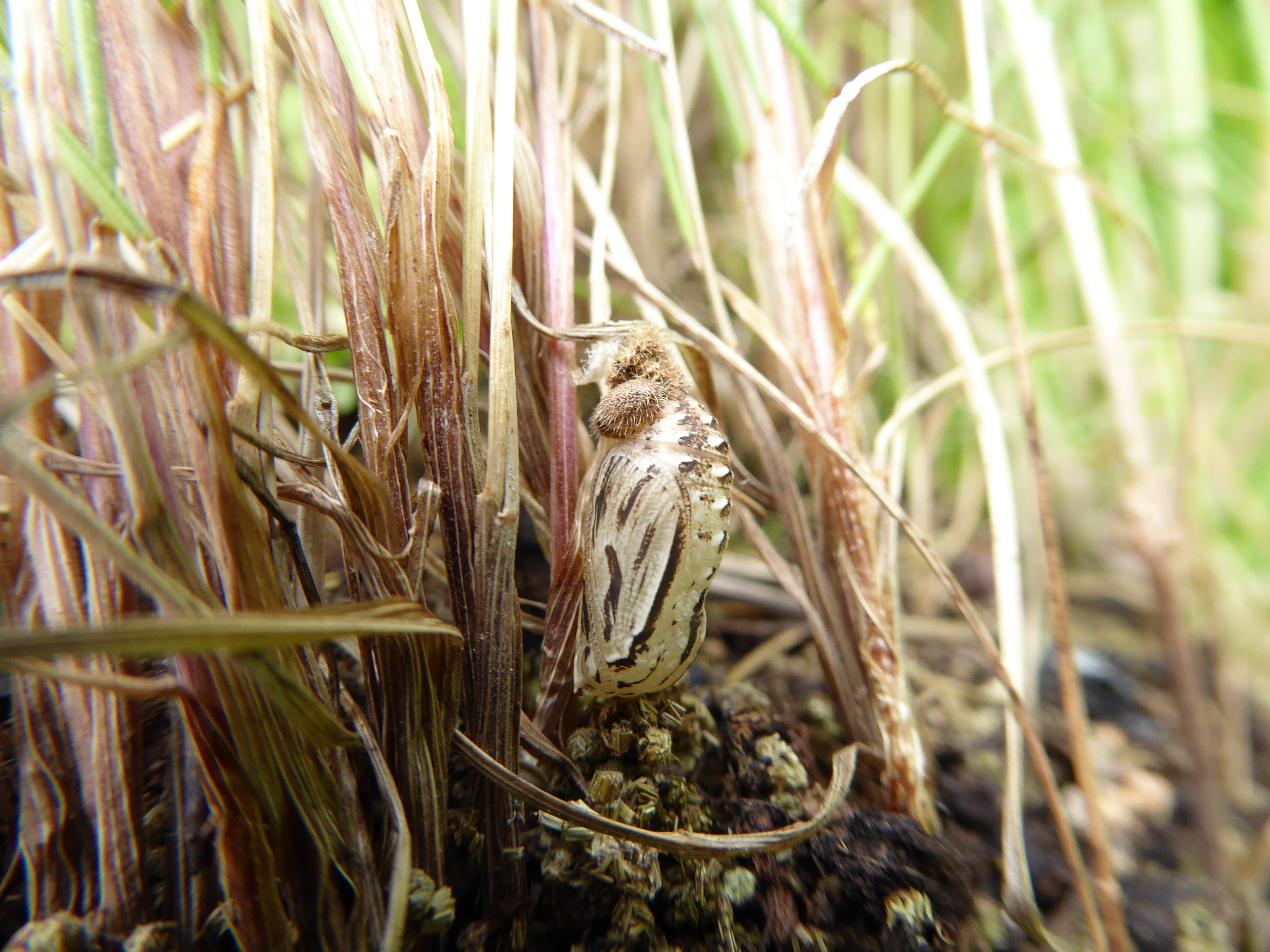 Hedge Brown Pupa.
Hedge Brown Pupa.
The adults emerged between 3rd and 18th July; the pupal stage lasting 23-25 days. Males emerged first, with the first females not emerging until 13th July. The emerging adult crawls up a grass blade and dries its wings, hanging suspended. Males patrol soon afterwards, in their search for females.
 Female Hedge Brown basking on bramble at The Raven, County Wexford. The Raven is one of the best sites in Ireland for butterflies.
Female Hedge Brown basking on bramble at The Raven, County Wexford. The Raven is one of the best sites in Ireland for butterflies.
DISTRIBUTION AND STATUS: The Hedge Brown is found in the south of Counties Kerry, Cork, Waterford, and Wexford. It is believed that this distribution reflects the larva’s need for the warmer springs that are experienced along Ireland’s south coast. Its continued restricted distribution in Ireland is unusual as it has expanded its range inland and much further north in Britain. This expansion is probably in response to climate change. Lack of suitable habitat may be preventing its spread inland in Ireland. This butterfly is not very mobile and intensively farmed inland areas in parts of Counties Cork, Waterford, Wexford may be the blocking problem. The factors inhibiting its spread northwards along the coast are open to debate. The butterfly may require continuous habitat along the coast to move; this is not present in many coastal areas. The butterfly is not a strong flyer and it may be reluctant to leave the shelter afforded by its breeding habitat. However, the fact that it clings closely to the south coast in much of its Irish range suggests that the key factor is the need for mild spring weather.
Elsewhere, its range is from Morocco to Britain excluding Scotland, eastwards to the Balkans, Greece and West Turkey. It does not occur in Northern Europe.
Its Red List status is near threatened due to population decline and a decline in the area occupied. This is certainly a species we need to keep a careful eye on and records of this butterfly will be gratefully accepted, whether obtained in 2018 or in previous years. Please check your note books!
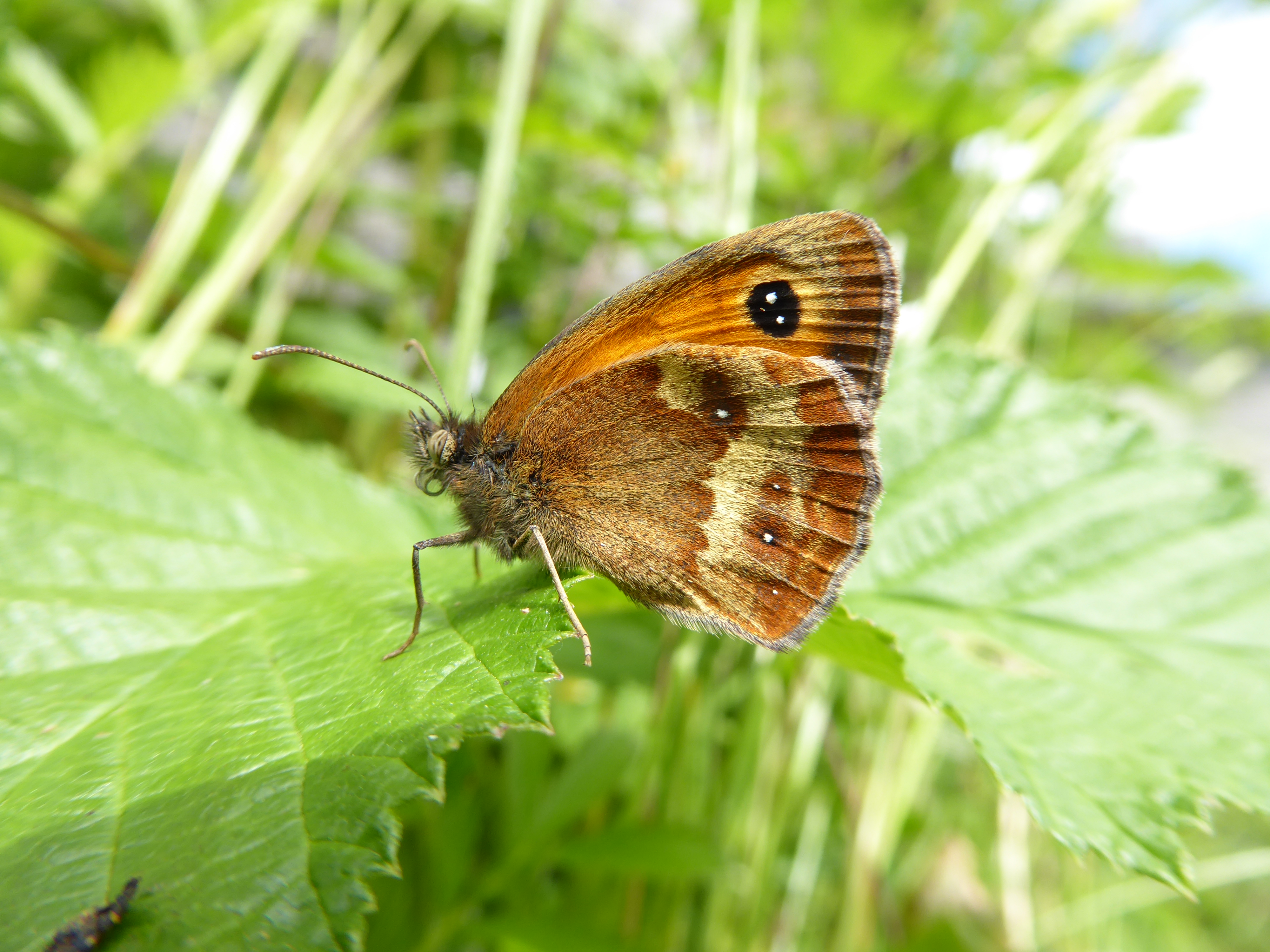 Hedge Brown (bred specimen) underside.
Hedge Brown (bred specimen) underside.
REFERENCES:
Fox, R., et al (2015). The State of the UK’s Butterflies 2015. Butterfly Conservation and the Centre for Ecology and Hydrology, Wareham, Dorset.
Harding, J (2008). Discovering Irish Butterflies & their Habitats. Privately published. Maynooth.
Nash, D., Boyd, T. and Hardiman, D. (2012) Ireland’s Butterflies A Review. The Dublin Naturalists’ Field Club, Dublin.
Regan, E.C., et al (2010) Ireland Red List No. 4 – Butterflies. National Parks and Wildlife Service, Department of the Environment, Heritage and Local Government, Ireland.
Thomas, J. and Lewington, R. (2010) The Butterflies of Britain and Ireland (Revised edition) British Wildlife Publishing, Dorset.
Tolman, T., and Lewington, L. (2009) Collins Butterfly Guide. Collins, London.
Photographs in this article are ©J. Harding.
A Visit to Two National Parks in Hungary
By Michael Friel.
My wife and I visited two National Parks in north-east Hungary from 7th till 11th June. We spent two days each in Aggtelek National Park and Bükk National Park. Both of these share a common substratum, namely limestone karst, and lie a short distance apart. Aggtelek is contiguous with Slovenský kras NP in Slovakia, and together they cover 545 sq. km, with 200 sq. km on the Hungarian side. Both parks are well known for having access points to one of the world’s most extensive cave systems, which runs for 16 km under the border.
Aggtelek NP has great wildlife diversity, including the European Grey Wolf and Brown bear; and, as Van Swaay and Warren noted (and it still seems to be true):” The area is very suitable for observing butterflies…here is a generally very harmonic landscape with a complex of semi-natural and partly traditionally used habitats.” In other words, there is not much damaging encroachment by man or beast.
We stayed in Aggtelek village and concentrated on 3 small areas within the park: the northern vicinity of this village, the Jósvafő village area and a country track between Szinpetri and Szin.
There are excellent meadows to the north-east of Aggtelek village. Between the main cave entrance and the village, near a disused hotel, the flowering grasslands had Chalk-hill Blues (Polyommatus coridon), an Idas Blue (Plebejus idas), Nickerl’s (Melitaea aurelia) and Weaver’s Fritillaries (Boloria dia) and Brown Argus (Aricia agestis) on the first afternoon. Then, after a short drive around the northern side of the village to the Jósvafő road, I took a marked trail leading off to the left, past privet bushes and across a hilly landscape reminiscent of the Burren, with many limestone outcrops. This area had Chestnut Heaths (Coenonympha glycerion), several Silver-studded Blues (Plebejus argus) and an Eastern Short-tailed Blue (Cupido decoloratus).
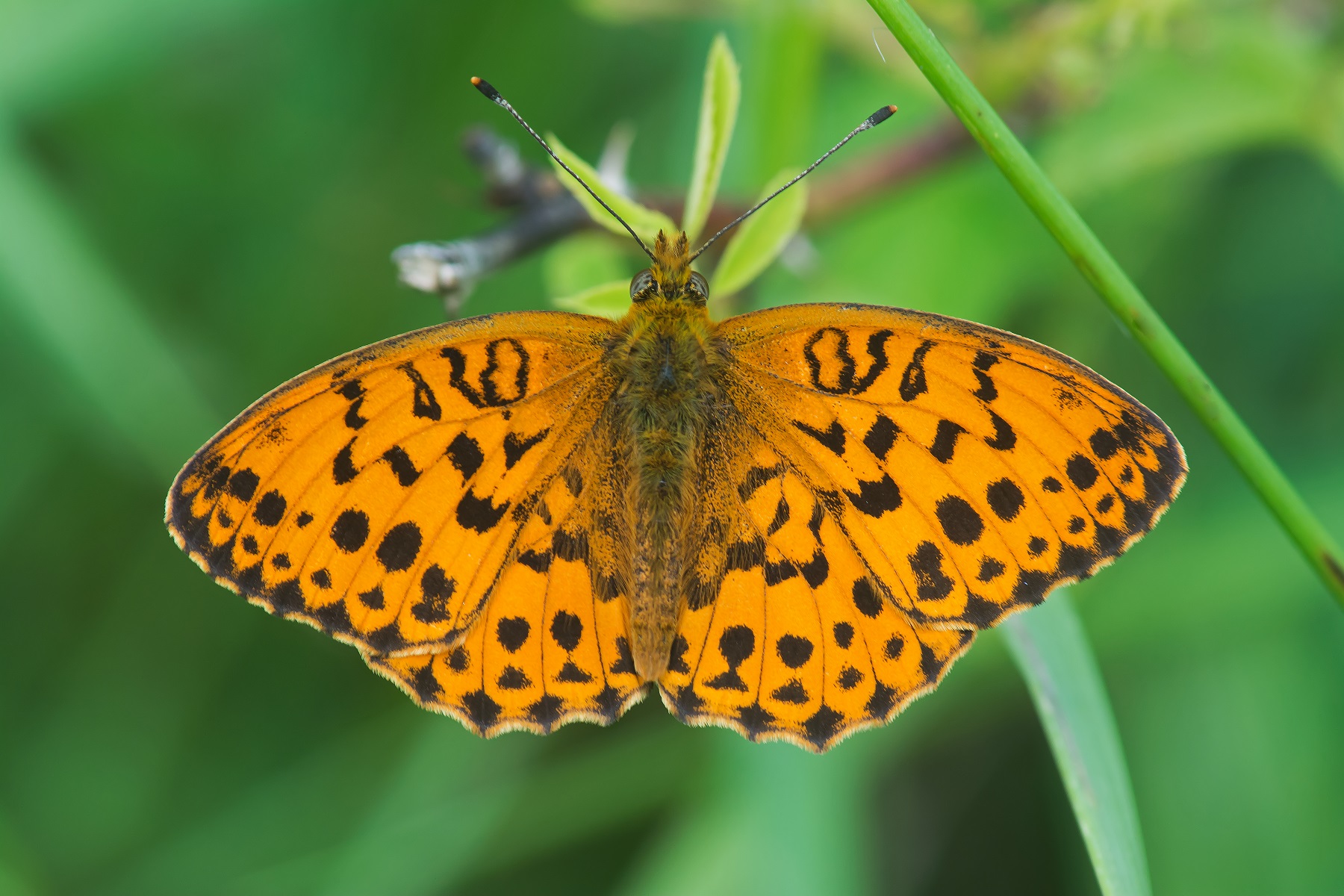 Marbled Fritillary. Photo M.Friel.
Marbled Fritillary. Photo M.Friel.
The following morning, I returned to these two places, finding near the hotel several Pearly Heaths (Coenonympha arcania) roosting in the small trees, a Black-veined White (Aporia crataegi), a Large Grizzled Skipper (Pyrgus alveus) and Heath Fritillaries (Melitaea althalia). At the second Aggtelek site, there were many Sloe Hairstreaks (Satyrium acaciae) fand a single Green Hairstreak – in the bushes, and I was pleased to see a Lesser Marbled Fritillary (Brenthis ino), as well as a Large Wall Brown (Lasiommata maera) in the open ground).
We then drove to Jósvafő village, where we saw High Brown Fritillaries (Argynnis adippe) and another Lesser Marbled Fritillary by the stream. After an excellent lunch in this charming village’s hotel, we drove on to the third area, near the village of Szin. Following a trail to the left, which started with a sandy area containing dozens of puddling Essex Skippers and Common Blues by the road, I climbed up a gentle slope, finding, among others, Marbled Fritillary (Brenthis daphne), Twin-spot Fritillary (Brenthis hecate) and Spotted Fritillary (Melitaea didyma), all enjoying the flowers in the scrubland. I was delighted to come across a Woodland Brown (Lopinga achine) in a trackside copse, as these have been evaluated as Vulnerable in Europe (van Swaay, et al). Walking back towards the road, I came across two very attractive Large Coppers (Lycaena dispar) in some long grass.
Back in Jósvafő, I took a track leading uphill out of the village, and immediately saw the languid flight of three gliders in bushes to the right. They were the aptly-named Hungarian Glider (Neptis rivularis), which, although widespread across Eurasia, owes its name to pioneering Hungarian entomologists. Further up the track I came across a very active White Admiral (Leminitis camilla), which proved to be the last new sighting of the day.
The next morning, I returned to the hotel meadows, where a Niobe Fritillary (Argynnis niobe) showed up. Then, soaring high over my head, an Eastern Imperial Eagle went past, surveying all below it. Just over 100 breeding pairs remain in Northern Hungary, one of its last major sites in Europe. We left Aggtelek and drove slowly southwards towards the second National Park. We took a detour to visit the historical town of Eger, and then wove our way up the Bükk Hills, beautifully shrouded in mainly beech trees (“bükk” meaning beech). The Bükk National Park covers 432 sq km, and is 94% hill-forested.
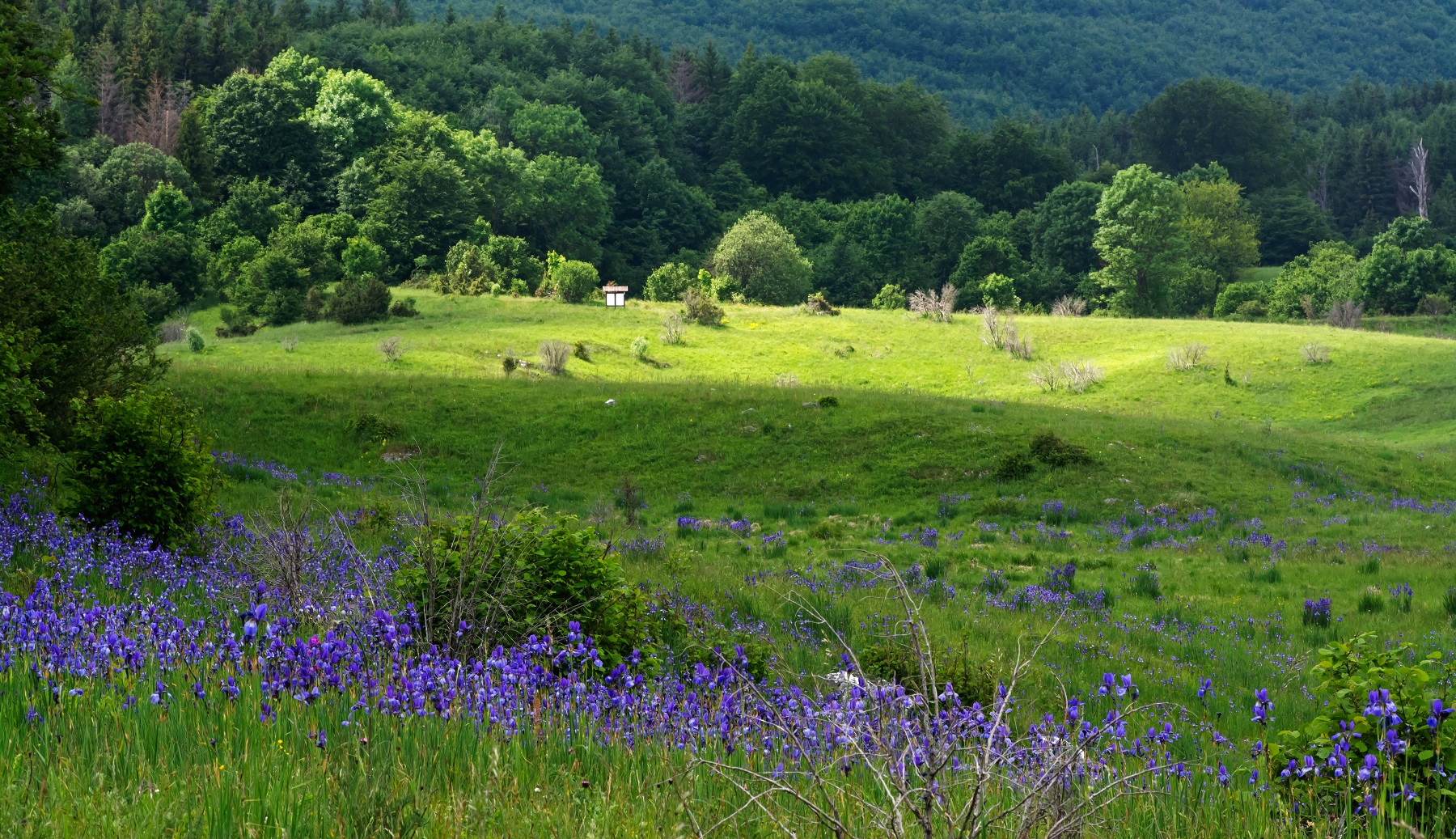 The Great Meadow, Bükk National Park. Photo M.Friel.
The Great Meadow, Bükk National Park. Photo M.Friel.
After we had settled in to our lodgings in the atmospheric village of Répáshuta, our kind hostess led us deep into the woods for about an hour, till we emerged in an elongated meadow stretching far downhill. This, and other meadows in the Park, came about after Slovak immigrants in the mid-19th century cut out areas of the forest for pasturing their cattle. Cattle-rearing is no longer a major activity, and the meadows are now well protected. They contain many wild flowers and herbs and naturally attract butterflies. The highlights for me in this long meadow were Assman’s (Melitaea britomartis) and Small Pearl-bordered Fritillaries (Boloria selene), and I also saw three other “Small” species, Skipper, Copper and Blue.
On the following day, I drove back for about 3 miles along the road taken to enter the town, then parked and walked uphill through the forest for about an hour along a road which led to Nagymező (great meadow), one of a group of adjacent meadows on the Bükk Plateau. My first impression was of blue water, which turned out to be swathes of irises in full bloom over a wide area (see photo on page 26). I spent some 3 hours there and, although the sun would come and go according to the whim of the heavy clouds, I managed to see the following: Glanville (Melitaea cinzia), Cranberry (Boloria aquilonaris) and False Heath Fritillaries (Melitaea diamin), a fine Purple-edged Copper (Lycaena hippothoe) and two Chequered Skippers (Carterocephalus palaemon). Orange Tips and Silver-washed Fritillaries were plentiful, as were day-flying moths, including a pair of mating Transparent Burnets.
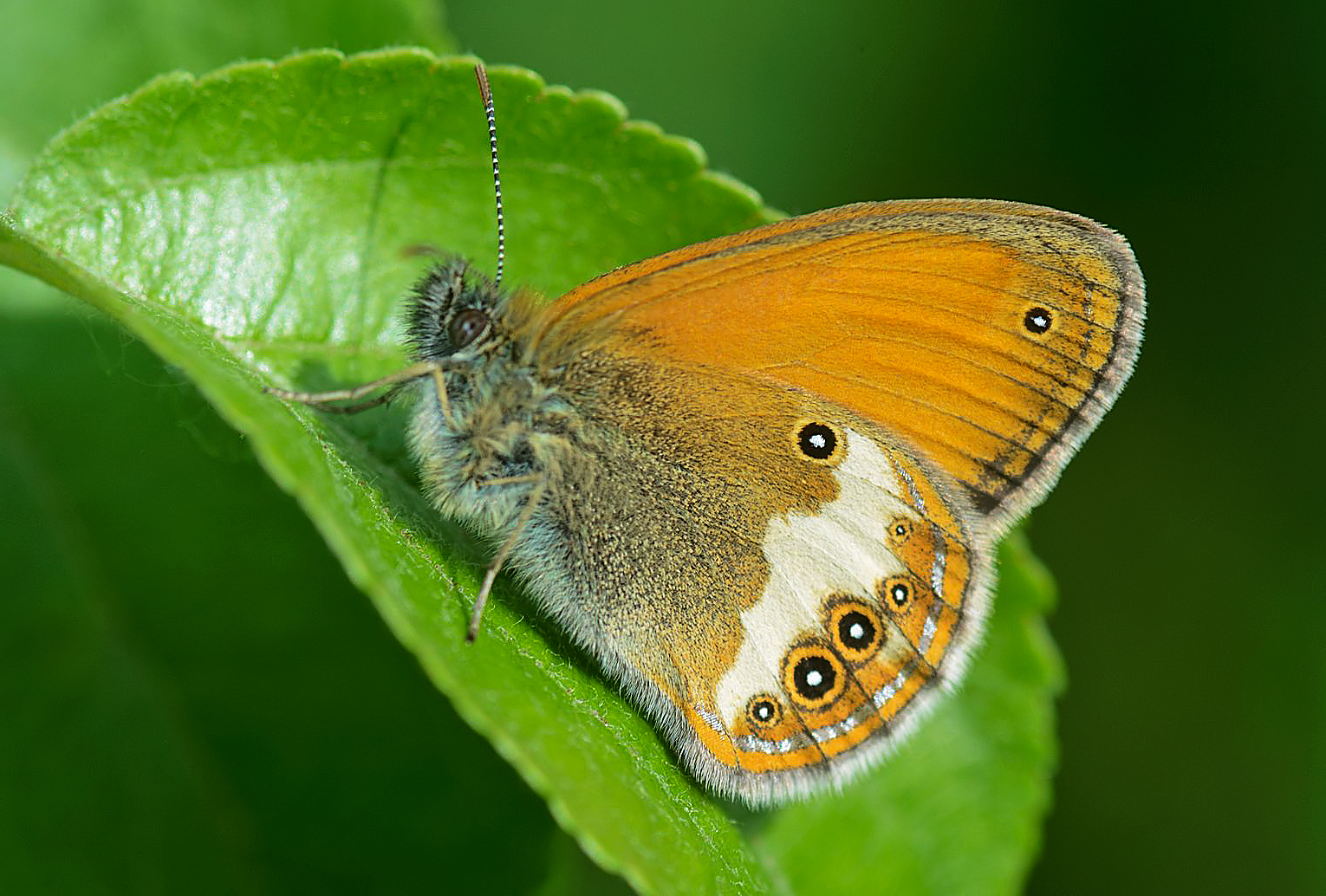 Pearly Heath. Photo M.Friel.
Pearly Heath. Photo M.Friel.
We moved on the next day, stopping for an hour at Noszvaj, in the south of Bükk NP, and more or less on the route to Budapest. In a pleasant wooded valley there were some 20 Silver-washed Fritillaries, together with a couple of Queen of Spain Fritillaries (Issoria lathonia) and one White Admiral, all drinking minerals from a sunny, damp spot in the middle of the path. I also saw my only Holly Blue, Speckled Wood and Nettle-tree Butterfly (Libythea celtis) of the trip here, the latter notable as the only snout butterfly species in Europe.
After travelling west to visit Budapest for 3 days, we drove back east, passing Aggtelek again, but not stopping, as there was one final interesting destination ahead of us. Across the border and into Slovakia, we made a stop at Turniansky hrad, an excellent National Nature Reserve at the eastern edge of Slovenský kras NP.
Climbing up in the afternoon to the 13th-century castle ruins, I soon came across several Graylings, as well as four species new for the trip, Marbled White (Melanargia galathea), Common Swallowtail (Papilio machaon), Chequered Blue (Scolitandes orion) and Blue-spot Hairstreak (Satyrium spini), all on the surrounding scrubby limestone slopes. There were also some beautiful and elusive Eastern Green Lizards scurrying through the long grass. Time on this occasion did not allow me to follow the ridge trail from the castle west to the Zadiel Gorge (which I had walked in 1991); this route surely would have added more butterflies to the list.
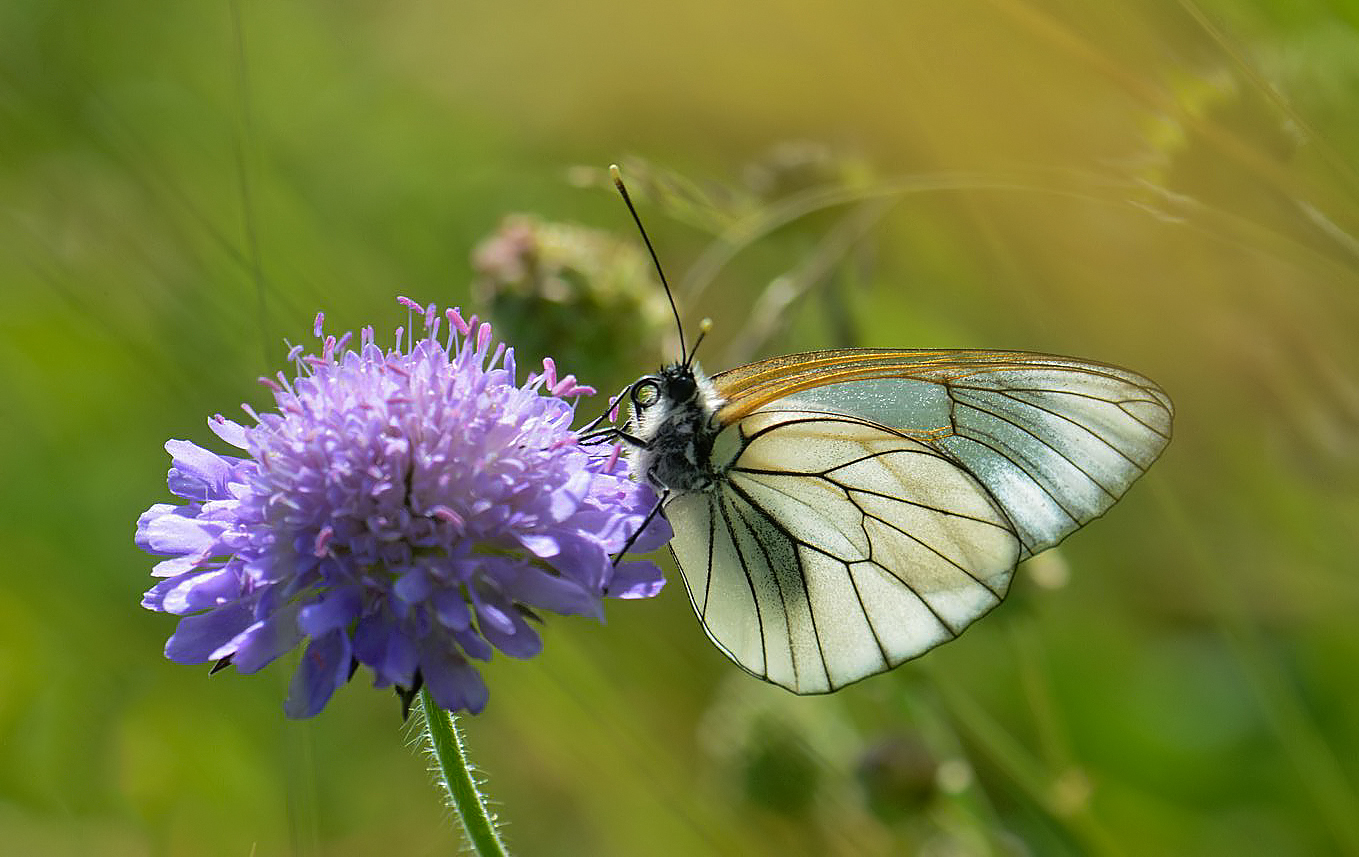 Black-veined White. Photo M. Friel.
Black-veined White. Photo M. Friel.
In the end, I calculated that we had seen 65 species, 26 of which can also be found in Ireland. The 16 fritillary species seen, most of them in excellent condition, indicate that this is a very good time and area to search for them. Of the butterflies recorded, in addition to the Vulnerable Woodland Brown, four of the fritillaries are Near Threatened (Assman’s, Nickerl’s, Niobe and False Heath), as are the Eastern Short-tailed Blue, Chequered Blue and Purple-edged Copper (Van Swaay et al).
Practicalities:
We flew from Knock to Luton by Ryanair, connecting with a WizzAir flight from Luton to Košice, Slovakia. We hired a car using www.edencars.sk (excellent English and they let us keep the car an extra night). You pay an additional 24 euros for driving into Hungary. However, it might be preferable for many to fly direct from Dublin to Budapest. The drive west from Košice to Aggtelek can be done in 90 minutes, while going eastwards from Budapest to Aggtelek would require at least 4 hours. Our Airbnb accommodation in Répáshuta was excellent, while for Aggtelek NP, if we return, we will surely stay in Jósvafő’s only hotel.
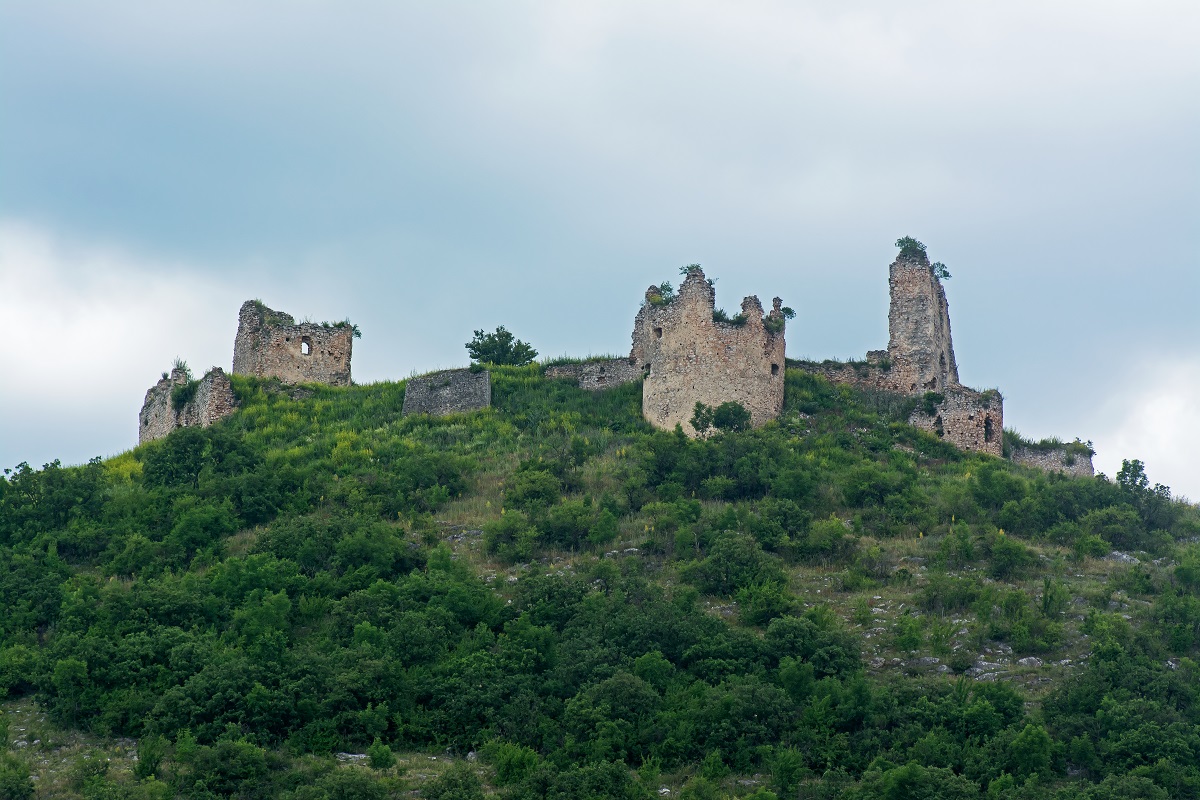 Turniansky hrad, Slovakia. Photo M. Friel.
Turniansky hrad, Slovakia. Photo M. Friel.
References:
Van Swaay, C. and Warren, M. (2003). Prime Butterfly Areas in Europe. De Vlinderstichtung (Dutch Butterfly Conservation) and British Butterfly Conservation.
Van Swaay C., et al (2010). European Red List of Butterflies. IUCN (International Union for Conservation of Nature) and Butterfly Conservation Europe, in collaboration with the European Union.
Websites:
http://www.anp.hu/en (Aggtelek NP)
http://en.bnpi.en/ (Bükk NP)
BUTTERFLY CONSERVATION IRELAND ANNUAL REPORT 2017
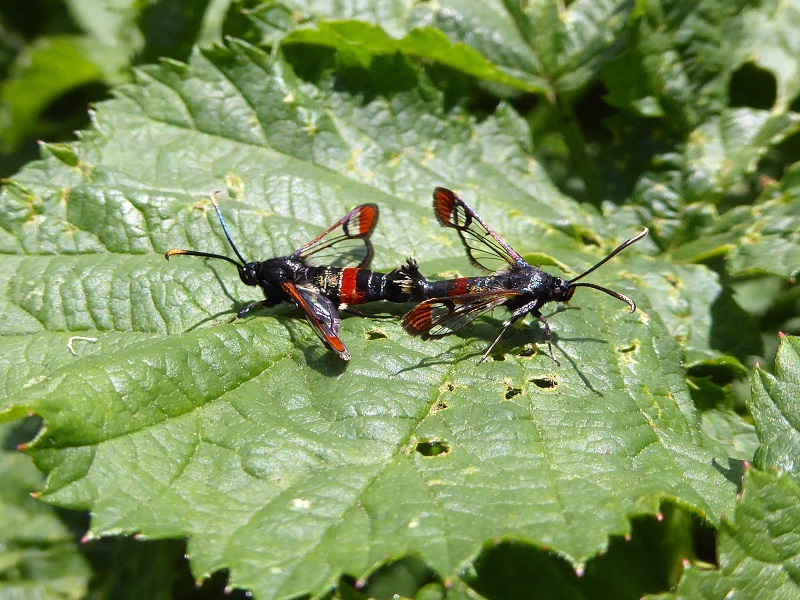 Mating pair of Red-tipped Clearwing moths, Lullybeg, County Kildare.
Mating pair of Red-tipped Clearwing moths, Lullybeg, County Kildare.
BUTTERFLY CONSERVATION IRELAND is a company limited by guarantee.
Registered in Ireland No. 451571.
BUTTERFLY CONSERVATION IRELAND is a charity.
Registered Charity no.: 20069131.
CONTACT DETAILS:
By email:
conservation.butterfly@gmail.com.
By post:
Butterfly Conservation Ireland,
Pagestown,
Maynooth,
County Kildare.
By phone: 01-6289901.
Website: https://butterflyconservation.ie/wp/
Facebook: https://www.facebook.com/ButterflyConservationIreland/

